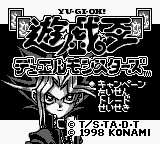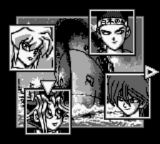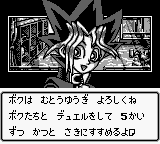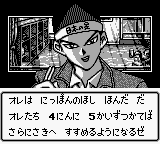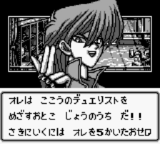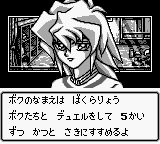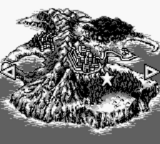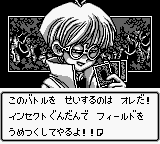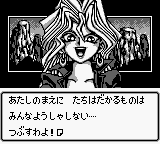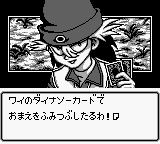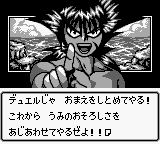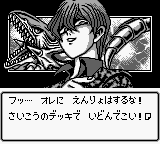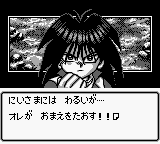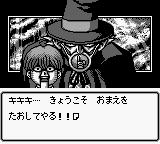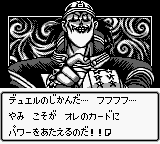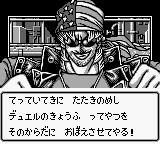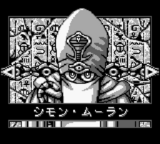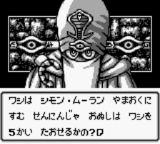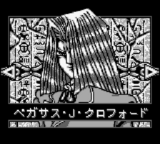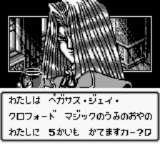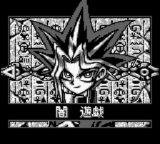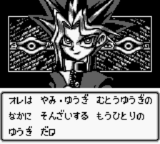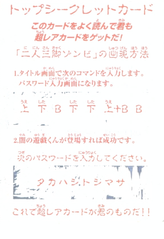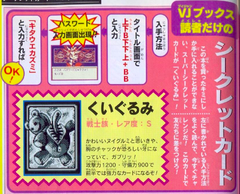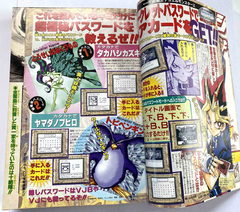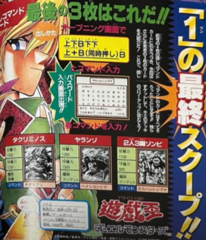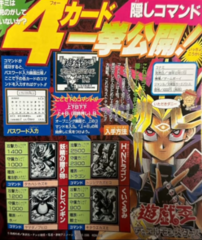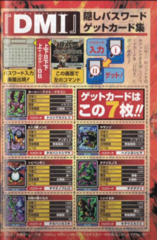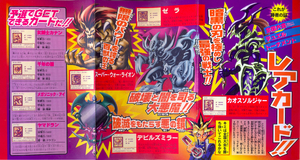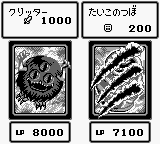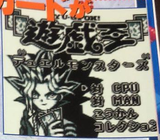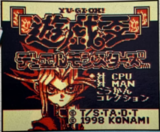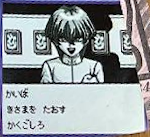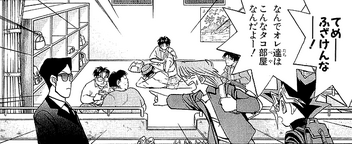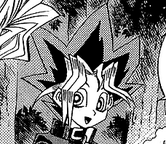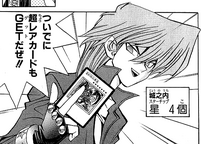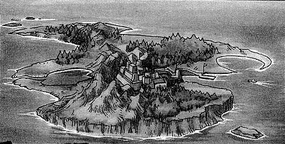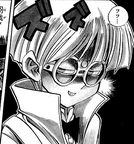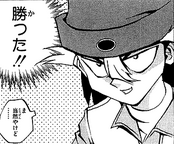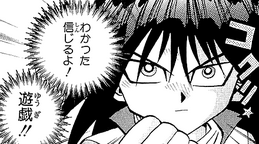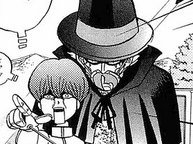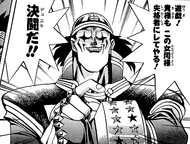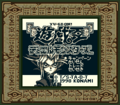Difference between revisions of "Yu-Gi-Oh! Duel Monsters (video game)"
({{Infobox video game}}) |
Dinoguy1000 (talk | contribs) (→Passwords: link WSJ 1999 #9 page) |
||
| (43 intermediate revisions by 5 users not shown) | |||
| Line 1: | Line 1: | ||
{{Infobox video game | {{Infobox video game | ||
| image = YugiohDuelMonstersGB.jpg | | image = YugiohDuelMonstersGB.jpg | ||
| − | | ja_name = {{Ruby| | + | | ja_name = {{Ruby|遊|ユウ}}{{Ruby|戯|ギ}}{{Ruby|王|オウ}}デュエルモンスターズ |
| − | | romaji_name = Yugiō | + | | romaji_name = Yugiō Dyueru Monsutāzu |
| platform = [[wikipedia:Game Boy|Game Boy]] | | platform = [[wikipedia:Game Boy|Game Boy]] | ||
| languages = Japanese | | languages = Japanese | ||
| developer = [[Konami]] | | developer = [[Konami]] | ||
| publisher = Konami | | publisher = Konami | ||
| − | | ja_release_date = December 16, 1998<ref name="konami dm1 page">http://www.konami.jp/products/yugioh_dm1_gb/</ref> | + | | ja_release_date = December 16, 1998<ref name="konami dm1 page">https://web.archive.org/web/20180826214725/http://www.konami.jp/products/yugioh_dm1_gb//</ref> |
| series = Yu-Gi-Oh! Duel Monsters (video game series) | | series = Yu-Gi-Oh! Duel Monsters (video game series) | ||
| next = Yu-Gi-Oh! Duel Monsters II: Dark duel Stories | | next = Yu-Gi-Oh! Duel Monsters II: Dark duel Stories | ||
| − | | | + | | guide_book_1 = Yu-Gi-Oh! Duel Monsters Perfect Master BOOK |
| − | | | + | | guide_book_2 = Yu-Gi-Oh! Duel Monsters Perfect Master BOOK Volume 2 |
}} | }} | ||
| − | '''''Yu-Gi-Oh! Duel Monsters''''' is the second ''Yu-Gi-Oh!'' video game, following ''[[Yu-Gi-Oh! Monster Capsule: Breed and Battle]]''. It is the first game in the [[Yu-Gi-Oh! Duel Monsters (video game series)|''Duel Monsters'' series]], followed by ''[[Yu-Gi-Oh! Duel Monsters II: Dark duel Stories]]'', and the only game released for the [[wikipedia:Game Boy|Game Boy]]. It was published in Japan by [[Konami]] on December 16, [[1998]];<ref name="konami dm1 page" /> while a few (non-''Yu-Gi-Oh!''-related) games would be released for the handheld over the next four years, ''Duel Monsters'' was one of the last games [[wikipedia:List of Game Boy games|published for the original Game Boy]]. | + | '''''Yu-Gi-Oh! Duel Monsters''''' is the second ''Yu-Gi-Oh!'' video game, following ''[[Yu-Gi-Oh! Monster Capsule: Breed and Battle]]''. It is the first game in the [[Yu-Gi-Oh! Duel Monsters (video game series)|''Duel Monsters'' series]], followed by ''[[Yu-Gi-Oh! Duel Monsters II: Dark duel Stories]]'', and the only game released for the [[wikipedia:Game Boy|Game Boy]]. |
| + | |||
| + | This game predates the ''[[OCG]]'' by two months, and many cards seen here soon made appearances in the earliest ''OCG'' sets. It was published in Japan by [[Konami]] on December 16, [[1998]];<ref name="konami dm1 page" /> while a few (non-''Yu-Gi-Oh!''-related) games would be released for the handheld over the next four years, ''Duel Monsters'' was one of the last games [[wikipedia:List of Game Boy games|published for the original Game Boy]]. | ||
==Cards== | ==Cards== | ||
{{Main|List of ''Yu-Gi-Oh! Duel Monsters'' cards|Gallery of ''Yu-Gi-Oh! Duel Monsters'' cards}} | {{Main|List of ''Yu-Gi-Oh! Duel Monsters'' cards|Gallery of ''Yu-Gi-Oh! Duel Monsters'' cards}} | ||
| − | ''Duel Monsters'' features 365 cards. | + | [[File:Takahashi's DM1 sketches.png|thumb|right|300px|Thirteen of the secret cards, which Takahashi designed for the game (the missing secret cards are #356: "[[Super War-lion (DM1)|Super War-lion]]" and #357: "[[Yamadron (DM1)|Yamadron]]")]] |
| + | ''Duel Monsters'' features 365 cards. These consist of: | ||
* 300 [[Monster Card|monsters]] and 50 [[Spell Card|Magic Cards]] accessible during normal gameplay: | * 300 [[Monster Card|monsters]] and 50 [[Spell Card|Magic Cards]] accessible during normal gameplay: | ||
| − | ** | + | ** 100 monsters and 12 Magic Cards from the [[Yu-Gi-Oh! (manga)|''Yu-Gi-Oh!'' manga]]. |
| + | *** The majority of these cards appear in chapters up to and including Duel 91: {{chapter|Yu-Gi-Oh!|91}}, released July 27, 1998. | ||
| + | *** Card #217: "[[B. Skull Dragon (DM1)|B. Skull Dragon]]" appears later in Duel 96: {{chapter|Yu-Gi-Oh!|96}}, released September 7, 1998. Unlike the other manga monsters, its card number is not within the first 100. | ||
| + | *** Card #067: "[[Perfectly Ultimate (DM1)|Perfectly Ultimate]]" is mentioned but not seen in the manga. It makes its first visual appearance in this game. | ||
** Card #013: "[[Tyhone (DM1)|Tyhone]]", which previously appeared in ''[[Yu-Gi-Oh! Monster Capsule: Breed and Battle]]'' | ** Card #013: "[[Tyhone (DM1)|Tyhone]]", which previously appeared in ''[[Yu-Gi-Oh! Monster Capsule: Breed and Battle]]'' | ||
| − | ** | + | ** 199 monsters and 38 Magic Cards, original to the game |
| + | *** At least 9 of these monsters were [[#Card-design contest|designed by fans]]. | ||
* 15 secret monsters, at least 13 of which were designed by [[Kazuki Takahashi]].<!-- "Super War-lion" and "Yamadron" are the uncounted. --> These can only be obtained through a [[#Passwords|secret password menu]] or as [[#Prizes|prizes]] at the [[Yu-Gi-Oh! Duel Monsters National Tournament|national tournament]]. | * 15 secret monsters, at least 13 of which were designed by [[Kazuki Takahashi]].<!-- "Super War-lion" and "Yamadron" are the uncounted. --> These can only be obtained through a [[#Passwords|secret password menu]] or as [[#Prizes|prizes]] at the [[Yu-Gi-Oh! Duel Monsters National Tournament|national tournament]]. | ||
| + | ** One of the 15, #364: "[[Black Luster Soldi (DM1)|Black Luster Soldi]]" appeared in the manga in Duel 117: {{chapter|Yu-Gi-Oh!|117}}, released February 15, 1999, roughly coinciding with the date it was made publicly available in the game, February 21, 1999. | ||
| − | + | {{-}} | |
==Game options== | ==Game options== | ||
[[File:YugiohDuelMonstersGB-2.png|thumb|right|The title screen and main menu]] | [[File:YugiohDuelMonstersGB-2.png|thumb|right|The title screen and main menu]] | ||
The following options are available at the main menu: | The following options are available at the main menu: | ||
| − | * '''[[#Campaign|Campaign]]''' (キャンペーン '' | + | * '''[[#Campaign|Campaign]]''' (キャンペーン ''Kyanpēn''): the game's story mode. Face AI opponents. |
| − | * '''[[#Versus|Versus]]''' (たいせん '' | + | * '''[[#Versus|Versus]]''' (たいせん ''Taisen''): battle other players, using the [[wikipedia:Game Link Cable|Game Link Cable]]. |
| − | * '''[[#Trade|Trade]]''' (トレード '' | + | * '''[[#Trade|Trade]]''' (トレード ''Torēdo''): trade with other players via the Game Link Cable. |
| − | * '''[[#Records|Records]]''' (せいせき '' | + | * '''[[#Records|Records]]''' (せいせき ''Seiseki''): statistics and other information about the player. |
There is also a [[#Passwords|password menu]], which is only accessible by entering a secret code at the main menu. | There is also a [[#Passwords|password menu]], which is only accessible by entering a secret code at the main menu. | ||
===Campaign=== | ===Campaign=== | ||
| − | ''Duel Monsters'' is set during the [[Duelist Kingdom (manga arc)|Duelist Kingdom arc]] of the manga | + | ''Duel Monsters'' is set during the [[Duelist Kingdom (manga arc)|Duelist Kingdom arc]] of the manga. |
| + | * The first stage is "'''In the Ship'''" ({{Ruby|船|ふね}}の{{Ruby|中|なか}} ''Fune no Naka'').<ref name="guidebook1 p25">{{cite book|date=December 21, 1998|title=[[Yu-Gi-Oh! Duel Monsters Perfect Master BOOK]]|publisher=[[Shueisha]]|page=25|isbn=4-08-779009-6|language=Japanese}}</ref> It takes place on the [[Duelist Kingdom ship]]. | ||
| + | * The second stage is "'''Duel Kingdom'''" (デュエル{{Ruby|王国|キングダム}} ''Dyueru Kingudamu'').<ref name="guidebook1 p25" /> It is set on the [[Duelist Kingdom (island)|Duelist Kingdom island]]. | ||
| + | * The third stage is "'''Simon Muran'''" (シモン・ムーラン ''Shimon Mūran''), a stage unrelated to the manga arc, featuring a character who debuts in this game. | ||
| + | * The final boss stage is "'''Maximillion Pegasus'''", known as "'''Pegasus J. Crawford'''" (ペガサス・{{Ruby|J|ジェー}}・クロフォード ''Pegasasu Jē Kurofōdo'') in Japan. | ||
| + | * The dark stage is "'''Yami Yugi'''", known as "'''Dark Yugi'''" ({{Ruby|闇|やみ}}{{Ruby|遊|ゆう}}{{Ruby|戯|ぎ}} ''Yami Yūgi'') in Japan. | ||
The player must defeat each character in a stage five times to advance to the next stage. A character that has been defeated five times can be Dueled additional times for more cards. Defeating [[Maximillion Pegasus (Duel Monsters 1)|Maximillion Pegasus]] five times causes the ending credits to roll. After that an additional Dark Stage appears, with [[Yami Yugi (Duel Monsters 1)|Yami Yugi]] as an opponent. | The player must defeat each character in a stage five times to advance to the next stage. A character that has been defeated five times can be Dueled additional times for more cards. Defeating [[Maximillion Pegasus (Duel Monsters 1)|Maximillion Pegasus]] five times causes the ending credits to roll. After that an additional Dark Stage appears, with [[Yami Yugi (Duel Monsters 1)|Yami Yugi]] as an opponent. | ||
| Line 47: | Line 60: | ||
|- | |- | ||
! scope="col" | Stage | ! scope="col" | Stage | ||
| − | |||
! scope="col" | Opponents | ! scope="col" | Opponents | ||
| − | |- | + | |- style="vertical-align: top;" |
| − | ! scope="row" | | + | ! scope="row" | |
| − | + | <gallery widths="160" heights="144" mode="nolines"> | |
| + | DM ST1.png | Stage 1: "In the Ship" | ||
| + | </gallery> | ||
| | | | ||
<gallery widths="160" heights="144" mode="nolines"> | <gallery widths="160" heights="144" mode="nolines"> | ||
| Line 59: | Line 73: | ||
Ryou Bakura-G1.png | [[Ryou Bakura (Duel Monsters 1)|Ryou Bakura]] | Ryou Bakura-G1.png | [[Ryou Bakura (Duel Monsters 1)|Ryou Bakura]] | ||
</gallery> | </gallery> | ||
| − | |- | + | |- style="vertical-align: top;" |
| − | ! scope="row" | | + | ! scope="row" | |
| − | + | <gallery widths="160" heights="144" mode="nolines"> | |
| + | DM ST2.png | Stage 2: "Duel Kingdom" | ||
| + | </gallery> | ||
| | | | ||
<gallery widths="160" heights="144" mode="nolines"> | <gallery widths="160" heights="144" mode="nolines"> | ||
| Line 74: | Line 90: | ||
Bandit Keith-DM1.png | [[Bandit Keith (Duel Monsters 1)|Bandit Keith]] | Bandit Keith-DM1.png | [[Bandit Keith (Duel Monsters 1)|Bandit Keith]] | ||
</gallery> | </gallery> | ||
| − | |- | + | |- style="vertical-align: top;" |
| − | + | ! scope="row" | | |
| − | ! scope="row" | | + | <gallery widths="160" heights="144" mode="nolines"> |
| − | + | DM ST3.png | Stage 3: "Simon Muran" | |
| + | </gallery> | ||
| | | | ||
<gallery widths="160" heights="144" mode="nolines"> | <gallery widths="160" heights="144" mode="nolines"> | ||
DM Siamun.png | [[Simon Muran (Duel Monsters 1)|Simon Muran]] | DM Siamun.png | [[Simon Muran (Duel Monsters 1)|Simon Muran]] | ||
</gallery> | </gallery> | ||
| − | |- | + | |- style="vertical-align: top;" |
| − | + | ! scope="row" | | |
| − | ! scope="row" | | + | <gallery widths="160" heights="144" mode="nolines"> |
| − | + | DM ST4.png | Final Boss: "Maximillion Pegasus" | |
| + | </gallery> | ||
| | | | ||
<gallery widths="160" heights="144" mode="nolines"> | <gallery widths="160" heights="144" mode="nolines"> | ||
DM Pegasus.png | [[Maximillion Pegasus (Duel Monsters 1)|Maximillion Pegasus]] | DM Pegasus.png | [[Maximillion Pegasus (Duel Monsters 1)|Maximillion Pegasus]] | ||
</gallery> | </gallery> | ||
| − | |- | + | |- style="vertical-align: top;" |
| − | + | ! scope="row" | | |
| − | ! scope="row" | | + | <gallery widths="160" heights="144" mode="nolines"> |
| − | + | DM ST5.png | Dark Stage: Yami Yugi | |
| + | </gallery> | ||
| | | | ||
<gallery widths="160" heights="144" mode="nolines"> | <gallery widths="160" heights="144" mode="nolines"> | ||
DM yami yugi.png | [[Yami Yugi (Duel Monsters 1)|Yami Yugi]] | DM yami yugi.png | [[Yami Yugi (Duel Monsters 1)|Yami Yugi]] | ||
</gallery> | </gallery> | ||
| − | |||
|} | |} | ||
| Line 105: | Line 123: | ||
After a battle, the winner can [[#Ante|take one card from the opponent's trunk]]. After every ten battles, the player is [[#Communication bonuses|awarded a certain card]]. | After a battle, the winner can [[#Ante|take one card from the opponent's trunk]]. After every ten battles, the player is [[#Communication bonuses|awarded a certain card]]. | ||
| + | |||
| + | If this option is selected without a second game being connected, [[Tea Gardner (Duel Monsters 1)|Tea Gardner]] appears and prevents the action. | ||
===Trade=== | ===Trade=== | ||
| Line 112: | Line 132: | ||
[[Communication Fusion]]s can be conducted by trading certain cards. | [[Communication Fusion]]s can be conducted by trading certain cards. | ||
| + | |||
| + | If this option is selected without a second game being connected, Tea Gardner prevents the action. | ||
===Records=== | ===Records=== | ||
| Line 117: | Line 139: | ||
==Obtaining cards== | ==Obtaining cards== | ||
| − | === | + | === Initial Deck === |
| − | + | {{Main|Initial Deck (''Duel Monsters 1'')}} | |
| − | All cards in the | + | The player starts the game with a 40-card [[Initial Deck]] which includes 33 Monster Cards, selected randomly from a pool of 100 monsters, as well as seven Magic Cards, which are always the same.<ref>https://datacrystal.tcrf.net/wiki/Yu-Gi-Oh!_Duel_Monsters:ROM_map#Starter_Deck_-_Random_card_pool</ref> |
| + | |||
| + | All cards in the Initial Deck are also available as drops, except for #337: "[[Raigeki (DM1)|Raigeki]]", which can only be obtained as a [[#Victory bonuses|victory bonus]]. In addition to being drops, sixteen other cards are also available as victory bonuses, and #289: "[[Change Slime (DM1)|Change Slime]]" is available as a [[#Communication bonuses|communication bonus]] (but not as a victory bonus). Victory bonus cards are indicated in the following tables with a pink background and a dagger (†) after the card's name, except for #337: "Raigeki", which instead uses a red background and a double dagger (‡). | ||
For display purposes, the list of monsters is split into groups of ten. This has no significance in-game, and is only done here for viewing convenience. | For display purposes, the list of monsters is split into groups of ten. This has no significance in-game, and is only done here for viewing convenience. | ||
| Line 443: | Line 467: | ||
The player wins a certain card from each opponent after every ten wins against that opponent, up to 100 wins. | The player wins a certain card from each opponent after every ten wins against that opponent, up to 100 wins. | ||
| − | Eighteen cards in the game are only available as victory bonuses; these are indicated in the below tables with a pink background and a superscript dagger (†) after the card's name. Specifically, the 100 victory bonus of every character is only available as a victory bonus, except for [[Mako Tsunami (Duel Monsters 1)|Mako Tsunami]]'s 100 victory bonus, #337 "[[Raigeki (DM1)|Raigeki]]", which the player's [[# | + | Eighteen cards in the game are only available as victory bonuses; these are indicated in the below tables with a pink background and a superscript dagger (†) after the card's name. Specifically, the 100 victory bonus of every character is only available as a victory bonus, except for [[Mako Tsunami (Duel Monsters 1)|Mako Tsunami]]'s 100 victory bonus, #337: "[[Raigeki (DM1)|Raigeki]]", which the player's [[#Initial Deck|Initial Deck]] contains one copy of. |
| − | Fourteen victory bonuses are also available as [[#Communication bonuses|communication bonuses]], indicated with a yellow background and a superscript double dagger (‡). Sixteen victory bonuses are also available in the [[# | + | Fourteen victory bonuses are also available as [[#Communication bonuses|communication bonuses]], indicated with a yellow background and a superscript double dagger (‡). Sixteen victory bonuses are also available in the [[#Initial Deck|Initial Deck]] (though none of them are also communication bonuses), indicated with a green background and a superscript section sign (§). All of these, except for #337: "Raigeki", are also available as drops, as are all of the other victory bonuses which are otherwise available. |
{| class="wikitable" style="display: inline-table;" | {| class="wikitable" style="display: inline-table;" | ||
| Line 456: | Line 480: | ||
|- | |- | ||
| 10 || 314 || [[Horn of the Unicor (DM1)|Horn of the Unicor]] | | 10 || 314 || [[Horn of the Unicor (DM1)|Horn of the Unicor]] | ||
| − | |- style="background-color: #cfc;" | + | |- style="background-color: #cfc; color: #222;" |
| 20 || 350 || [[Dark-piercing Ligh (DM1)|Dark-piercing Ligh]]<sup>§</sup> | | 20 || 350 || [[Dark-piercing Ligh (DM1)|Dark-piercing Ligh]]<sup>§</sup> | ||
| − | |- style="background-color: #cfc;" | + | |- style="background-color: #cfc; color: #222;" |
| 30 || 199 || [[Penguin Knight (DM1)|Penguin Knight]]<sup>§</sup> | | 30 || 199 || [[Penguin Knight (DM1)|Penguin Knight]]<sup>§</sup> | ||
| − | |- style="background-color: #cfc;" | + | |- style="background-color: #cfc; color: #222;" |
| 40 || 161 || [[M-warrior 2 (DM1)|M-warrior #2]]<sup>§</sup> | | 40 || 161 || [[M-warrior 2 (DM1)|M-warrior #2]]<sup>§</sup> | ||
|- | |- | ||
| Line 468: | Line 492: | ||
|- | |- | ||
| 70 || 118 || [[Supporter in the S (DM1)|Supporter in the S]] | | 70 || 118 || [[Supporter in the S (DM1)|Supporter in the S]] | ||
| − | |- style="background-color: #cfc;" | + | |- style="background-color: #cfc; color: #222;" |
| 80 || 276 || [[Ray & Temperature (DM1)|Ray & Temperature]]<sup>§</sup> | | 80 || 276 || [[Ray & Temperature (DM1)|Ray & Temperature]]<sup>§</sup> | ||
| − | |- style="background-color: #fcc;" | + | |- style="background-color: #fcc; color: #222;" |
| 90 || 039 || [[Curse of Dragon (DM1)|Curse of Dragon]]<sup>†</sup> | | 90 || 039 || [[Curse of Dragon (DM1)|Curse of Dragon]]<sup>†</sup> | ||
| − | |- style="background-color: #fcc;" | + | |- style="background-color: #fcc; color: #222;" |
| 100 || 038 || [[Gaia The Fierce Kn (DM1)|Gaia The Fierce Kn]]<sup>†</sup> | | 100 || 038 || [[Gaia The Fierce Kn (DM1)|Gaia The Fierce Kn]]<sup>†</sup> | ||
|} | |} | ||
| Line 487: | Line 511: | ||
|- | |- | ||
| 20 || 312 || [[Silver Bow & Arrow (DM1)|Silver Bow & Arrow]] | | 20 || 312 || [[Silver Bow & Arrow (DM1)|Silver Bow & Arrow]] | ||
| − | |- style="background-color: #cfc;" | + | |- style="background-color: #cfc; color: #222;" |
| 30 || 238 || [[Yashinoki (DM1)|Yashinoki]]<sup>§</sup> | | 30 || 238 || [[Yashinoki (DM1)|Yashinoki]]<sup>§</sup> | ||
| − | |- style="background-color: #cfc;" | + | |- style="background-color: #cfc; color: #222;" |
| 40 || 300 || [[Kurama (DM1)|Kurama]]<sup>§</sup> | | 40 || 300 || [[Kurama (DM1)|Kurama]]<sup>§</sup> | ||
| − | |- style="background-color: #cfc;" | + | |- style="background-color: #cfc; color: #222;" |
| 50 || 155 || [[Larvas (DM1)|Larvas]]<sup>§</sup> | | 50 || 155 || [[Larvas (DM1)|Larvas]]<sup>§</sup> | ||
| − | |- style="background-color: #cfc;" | + | |- style="background-color: #cfc; color: #222;" |
| 60 || 180 || [[Arlownay (DM1)|Arlownay]]<sup>§</sup> | | 60 || 180 || [[Arlownay (DM1)|Arlownay]]<sup>§</sup> | ||
|- | |- | ||
| 70 || 257 || [[Stone Armadiller (DM1)|Stone Armadiller]] | | 70 || 257 || [[Stone Armadiller (DM1)|Stone Armadiller]] | ||
| − | |- style="background-color: #cfc;" | + | |- style="background-color: #cfc; color: #222;" |
| 80 || 174 || [[Hurricail (DM1)|Hurricail]]<sup>§</sup> | | 80 || 174 || [[Hurricail (DM1)|Hurricail]]<sup>§</sup> | ||
|- | |- | ||
| 90 || 252 || [[Nekogal 1 (DM1)|Nekogal #1]] | | 90 || 252 || [[Nekogal 1 (DM1)|Nekogal #1]] | ||
| − | |- style="background-color: #fcc;" | + | |- style="background-color: #fcc; color: #222;" |
| 100 || 018 || [[L Leg of Forbidden (DM1)|L Leg of Forbidden]]<sup>†</sup> | | 100 || 018 || [[L Leg of Forbidden (DM1)|L Leg of Forbidden]]<sup>†</sup> | ||
|} | |} | ||
| Line 528: | Line 552: | ||
|- | |- | ||
| 80 || 068 || [[Garoozis (DM1)|Garoozis]] | | 80 || 068 || [[Garoozis (DM1)|Garoozis]] | ||
| − | |- style="background-color: #ffc;" | + | |- style="background-color: #ffc; color: #222;" |
| 90 || 016 || [[Time Wizard (DM1)|Time Wizard]]<sup>‡</sup> | | 90 || 016 || [[Time Wizard (DM1)|Time Wizard]]<sup>‡</sup> | ||
| − | |- style="background-color: #fcc;" | + | |- style="background-color: #fcc; color: #222;" |
| 100 || 082 || [[Red-eyes B. Dragon (DM1)|Red-eyes B. Dragon]]<sup>†</sup> | | 100 || 082 || [[Red-eyes B. Dragon (DM1)|Red-eyes B. Dragon]]<sup>†</sup> | ||
|} | |} | ||
| Line 545: | Line 569: | ||
|- | |- | ||
| 20 || 236 || [[Guardian of the La (DM1)|Guardian of the La]] | | 20 || 236 || [[Guardian of the La (DM1)|Guardian of the La]] | ||
| − | |- style="background-color: #cfc;" | + | |- style="background-color: #cfc; color: #222;" |
| 30 || 338 || [[Mooyan Curry (DM1)|Mooyan Curry]]<sup>§</sup> | | 30 || 338 || [[Mooyan Curry (DM1)|Mooyan Curry]]<sup>§</sup> | ||
|- | |- | ||
| 40 || 294 || [[Dragoness the Wick (DM1)|Dragoness the Wick]] | | 40 || 294 || [[Dragoness the Wick (DM1)|Dragoness the Wick]] | ||
| − | |- style="background-color: #cfc;" | + | |- style="background-color: #cfc; color: #222;" |
| 50 || 339 || [[Red Medicine (DM1)|Red Medicine]]<sup>§</sup> | | 50 || 339 || [[Red Medicine (DM1)|Red Medicine]]<sup>§</sup> | ||
|- | |- | ||
| − | | 60 || 259 || [[ | + | | 60 || 259 || [[Dimensional Knight (DM1)|Dimensional Knight]] |
| − | |- style="background-color: #ffc;" | + | |- style="background-color: #ffc; color: #222;" |
| 70 || 340 || [[Goblin's Secret Re (DM1)|Goblin's Secret Re]]<sup>‡</sup> | | 70 || 340 || [[Goblin's Secret Re (DM1)|Goblin's Secret Re]]<sup>‡</sup> | ||
|- | |- | ||
| 80 || 225 || [[Fiend Sword (DM1)|Fiend Sword]] | | 80 || 225 || [[Fiend Sword (DM1)|Fiend Sword]] | ||
| − | |- style="background-color: #fcc;" | + | |- style="background-color: #fcc; color: #222;" |
| 90 || 341 || [[Soul of the Pure (DM1)|Soul of the Pure]]<sup>†</sup> | | 90 || 341 || [[Soul of the Pure (DM1)|Soul of the Pure]]<sup>†</sup> | ||
| − | |- style="background-color: #fcc;" | + | |- style="background-color: #fcc; color: #222;" |
| 100 || 342 || [[Dian Keto the Cure (DM1)|Dian Keto the Cure]]<sup>†</sup> | | 100 || 342 || [[Dian Keto the Cure (DM1)|Dian Keto the Cure]]<sup>†</sup> | ||
|} | |} | ||
| Line 586: | Line 610: | ||
|- | |- | ||
| 80 || 055 || [[Giant Flea (DM1)|Giant Flea]] | | 80 || 055 || [[Giant Flea (DM1)|Giant Flea]] | ||
| − | |- style="background-color: #ffc;" | + | |- style="background-color: #ffc; color: #222;" |
| 90 || 052 || [[Hercules Beetle (DM1)|Hercules Beetle]]<sup>‡</sup> | | 90 || 052 || [[Hercules Beetle (DM1)|Hercules Beetle]]<sup>‡</sup> | ||
| − | |- style="background-color: #fcc;" | + | |- style="background-color: #fcc; color: #222;" |
| 100 || 278 || [[Petit Moth (DM1)|Petit Moth]]<sup>†</sup> | | 100 || 278 || [[Petit Moth (DM1)|Petit Moth]]<sup>†</sup> | ||
|} | |} | ||
| Line 609: | Line 633: | ||
|- | |- | ||
| 50 || 272 || [[Mavelus (DM1)|Mavelus]] | | 50 || 272 || [[Mavelus (DM1)|Mavelus]] | ||
| − | |- style="background-color: #ffc;" | + | |- style="background-color: #ffc; color: #222;" |
| 60 || 316 || [[Electro-whip (DM1)|Electro-whip]]<sup>‡</sup> | | 60 || 316 || [[Electro-whip (DM1)|Electro-whip]]<sup>‡</sup> | ||
|- | |- | ||
| Line 615: | Line 639: | ||
|- | |- | ||
| 80 || 125 || [[Faith Bird (DM1)|Faith Bird]] | | 80 || 125 || [[Faith Bird (DM1)|Faith Bird]] | ||
| − | |- style="background-color: #ffc;" | + | |- style="background-color: #ffc; color: #222;" |
| 90 || 317 || [[Cyber Shield (DM1)|Cyber Shield]]<sup>‡</sup> | | 90 || 317 || [[Cyber Shield (DM1)|Cyber Shield]]<sup>‡</sup> | ||
| − | |- style="background-color: #fcc;" | + | |- style="background-color: #fcc; color: #222;" |
| 100 || 063 || [[Harpie Lady Sister (DM1)|Harpie Lady Sister]]<sup>†</sup> | | 100 || 063 || [[Harpie Lady Sister (DM1)|Harpie Lady Sister]]<sup>†</sup> | ||
|} | |} | ||
| Line 636: | Line 660: | ||
|- | |- | ||
| 40 || 081 || [[Crawling Dragon 2 (DM1)|Crawling Dragon #2]] | | 40 || 081 || [[Crawling Dragon 2 (DM1)|Crawling Dragon #2]] | ||
| − | |- style="background-color: #ffc;" | + | |- style="background-color: #ffc; color: #222;" |
| 50 || 011 || [[Sword Arm of Drago (DM1)|Sword Arm of Drago]]<sup>‡</sup> | | 50 || 011 || [[Sword Arm of Drago (DM1)|Sword Arm of Drago]]<sup>‡</sup> | ||
|- | |- | ||
| Line 642: | Line 666: | ||
|- | |- | ||
| 70 || 081 || [[Crawling Dragon 2 (DM1)|Crawling Dragon #2]] | | 70 || 081 || [[Crawling Dragon 2 (DM1)|Crawling Dragon #2]] | ||
| − | |- style="background-color: #ffc;" | + | |- style="background-color: #ffc; color: #222;" |
| 80 || 011 || [[Sword Arm of Drago (DM1)|Sword Arm of Drago]]<sup>‡</sup> | | 80 || 011 || [[Sword Arm of Drago (DM1)|Sword Arm of Drago]]<sup>‡</sup> | ||
| − | |- style="background-color: #ffc;" | + | |- style="background-color: #ffc; color: #222;" |
| 90 || 079 || [[Megazowler (DM1)|Megazowler]]<sup>‡</sup> | | 90 || 079 || [[Megazowler (DM1)|Megazowler]]<sup>‡</sup> | ||
| − | |- style="background-color: #fcc;" | + | |- style="background-color: #fcc; color: #222;" |
| 100 || 032 || [[Two-headed King Re (DM1)|Two-headed King Re]]<sup>†</sup> | | 100 || 032 || [[Two-headed King Re (DM1)|Two-headed King Re]]<sup>†</sup> | ||
|} | |} | ||
| Line 667: | Line 691: | ||
|- | |- | ||
| 50 || 071 || [[Jellyfish (DM1)|Jellyfish]] | | 50 || 071 || [[Jellyfish (DM1)|Jellyfish]] | ||
| − | |- style="background-color: #ffc;" | + | |- style="background-color: #ffc; color: #222;" |
| 60 || 073 || [[Kairyu-shin (DM1)|Kairyu-shin]]<sup>‡</sup> | | 60 || 073 || [[Kairyu-shin (DM1)|Kairyu-shin]]<sup>‡</sup> | ||
|- | |- | ||
| Line 673: | Line 697: | ||
|- | |- | ||
| 80 || 071 || [[Jellyfish (DM1)|Jellyfish]] | | 80 || 071 || [[Jellyfish (DM1)|Jellyfish]] | ||
| − | |- style="background-color: #ffc;" | + | |- style="background-color: #ffc; color: #222;" |
| 90 || 073 || [[Kairyu-shin (DM1)|Kairyu-shin]]<sup>‡</sup> | | 90 || 073 || [[Kairyu-shin (DM1)|Kairyu-shin]]<sup>‡</sup> | ||
| − | |- style="background-color: #cfc;" | + | |- style="background-color: #cfc; color: #222;" |
| 100 || 337 || [[Raigeki (DM1)|Raigeki]]<sup>§</sup> | | 100 || 337 || [[Raigeki (DM1)|Raigeki]]<sup>§</sup> | ||
|} | |} | ||
| Line 690: | Line 714: | ||
|- | |- | ||
| 20 || 321 || [[Malevolent Nuzzler (DM1)|Malevolent Nuzzler]] | | 20 || 321 || [[Malevolent Nuzzler (DM1)|Malevolent Nuzzler]] | ||
| − | |- style="background-color: #cfc;" | + | |- style="background-color: #cfc; color: #222;" |
| 30 || 005 || [[Ryu-kishin (DM1)|Ryu-kishin]]<sup>§</sup> | | 30 || 005 || [[Ryu-kishin (DM1)|Ryu-kishin]]<sup>§</sup> | ||
|- | |- | ||
| Line 698: | Line 722: | ||
|- | |- | ||
| 60 || 023 || [[The Wicked Worm B (DM1)|The Wicked Worm B]] | | 60 || 023 || [[The Wicked Worm B (DM1)|The Wicked Worm B]] | ||
| − | |- style="background-color: #ffc;" | + | |- style="background-color: #ffc; color: #222;" |
| 70 || 026 || [[Battle Ox (DM1)|Battle Ox]]<sup>‡</sup> | | 70 || 026 || [[Battle Ox (DM1)|Battle Ox]]<sup>‡</sup> | ||
|- | |- | ||
| 80 || 033 || [[Judge Man (DM1)|Judge Man]] | | 80 || 033 || [[Judge Man (DM1)|Judge Man]] | ||
| − | |- style="background-color: #ffc;" | + | |- style="background-color: #ffc; color: #222;" |
| 90 || 090 || [[Gyakutenno Megami (DM1)|Gyakutenno Megami]]<sup>‡</sup> | | 90 || 090 || [[Gyakutenno Megami (DM1)|Gyakutenno Megami]]<sup>‡</sup> | ||
| − | |- style="background-color: #fcc;" | + | |- style="background-color: #fcc; color: #222;" |
| 100 || 001 || [[B.eye White Dragon (DM1)|B.eye White Dragon]]<sup>†</sup> | | 100 || 001 || [[B.eye White Dragon (DM1)|B.eye White Dragon]]<sup>†</sup> | ||
|} | |} | ||
| Line 721: | Line 745: | ||
|- | |- | ||
| 30 || 324 || [[Invigoration (DM1)|Invigoration]] | | 30 || 324 || [[Invigoration (DM1)|Invigoration]] | ||
| − | |- style="background-color: #cfc;" | + | |- style="background-color: #cfc; color: #222;" |
| 40 || 075 || [[Man-eating Plant (DM1)|Man-eating Plant]]<sup>§</sup> | | 40 || 075 || [[Man-eating Plant (DM1)|Man-eating Plant]]<sup>§</sup> | ||
| − | |- style="background-color: #cfc;" | + | |- style="background-color: #cfc; color: #222;" |
| 50 || 102 || [[Mask of Darkness (DM1)|Mask of Darkness]]<sup>§</sup> | | 50 || 102 || [[Mask of Darkness (DM1)|Mask of Darkness]]<sup>§</sup> | ||
|- | |- | ||
| 60 || 076 || [[Krokodilus (DM1)|Krokodilus]] | | 60 || 076 || [[Krokodilus (DM1)|Krokodilus]] | ||
| − | |- style="background-color: #ffc;" | + | |- style="background-color: #ffc; color: #222;" |
| 70 || 051 || [[Armored Lizard (DM1)|Armored Lizard]]<sup>‡</sup> | | 70 || 051 || [[Armored Lizard (DM1)|Armored Lizard]]<sup>‡</sup> | ||
| − | |- style="background-color: #ffc;" | + | |- style="background-color: #ffc; color: #222;" |
| 80 || 066 || [[Kojikocy (DM1)|Kojikocy]]<sup>‡</sup> | | 80 || 066 || [[Kojikocy (DM1)|Kojikocy]]<sup>‡</sup> | ||
|- | |- | ||
| 90 || 234 || [[Beautiful Headhunt (DM1)|Beautiful Headhunt]] | | 90 || 234 || [[Beautiful Headhunt (DM1)|Beautiful Headhunt]] | ||
| − | |- style="background-color: #fcc;" | + | |- style="background-color: #fcc; color: #222;" |
| 100 || 017 || [[R Leg of Forbidden (DM1)|R Leg of Forbidden]]<sup>†</sup> | | 100 || 017 || [[R Leg of Forbidden (DM1)|R Leg of Forbidden]]<sup>†</sup> | ||
|} | |} | ||
| Line 762: | Line 786: | ||
|- | |- | ||
| 90 || 286 || [[Gatekeeper (DM1)|Gatekeeper]] | | 90 || 286 || [[Gatekeeper (DM1)|Gatekeeper]] | ||
| − | |- style="background-color: #fcc;" | + | |- style="background-color: #fcc; color: #222;" |
| 100 || 019 || [[R Arm of Forbidden (DM1)|R Arm of Forbidden]]<sup>†</sup> | | 100 || 019 || [[R Arm of Forbidden (DM1)|R Arm of Forbidden]]<sup>†</sup> | ||
|} | |} | ||
| Line 791: | Line 815: | ||
|- | |- | ||
| 90 || 127 || [[Ansatsu (DM1)|Ansatsu]] | | 90 || 127 || [[Ansatsu (DM1)|Ansatsu]] | ||
| − | |- style="background-color: #fcc;" | + | |- style="background-color: #fcc; color: #222;" |
| 100 || 085 || [[King of Yamimakai (DM1)|King of Yamimakai]]<sup>†</sup> | | 100 || 085 || [[King of Yamimakai (DM1)|King of Yamimakai]]<sup>†</sup> | ||
|} | |} | ||
| Line 818: | Line 842: | ||
|- | |- | ||
| 80 || 124 || [[Ancient Tool (DM1)|Ancient Tool]] | | 80 || 124 || [[Ancient Tool (DM1)|Ancient Tool]] | ||
| − | |- style="background-color: #fcc;" | + | |- style="background-color: #fcc; color: #222;" |
| 90 || 099 || [[Pumpking the King (DM1)|Pumpking the King]]<sup>†</sup> | | 90 || 099 || [[Pumpking the King (DM1)|Pumpking the King]]<sup>†</sup> | ||
| − | |- style="background-color: #fcc;" | + | |- style="background-color: #fcc; color: #222;" |
| 100 || 020 || [[L Arm of Forbidden (DM1)|L Arm of Forbidden]]<sup>†</sup> | | 100 || 020 || [[L Arm of Forbidden (DM1)|L Arm of Forbidden]]<sup>†</sup> | ||
|} | |} | ||
| Line 843: | Line 867: | ||
|- | |- | ||
| 60 || 213 || [[Aqua Madoor (DM1)|Aqua Madoor]] | | 60 || 213 || [[Aqua Madoor (DM1)|Aqua Madoor]] | ||
| − | |- style="background-color: #cfc;" | + | |- style="background-color: #cfc; color: #222;" |
| 70 || 145 || [[Phantom Thief (DM1)|Phantom Thief]]<sup>§</sup> | | 70 || 145 || [[Phantom Thief (DM1)|Phantom Thief]]<sup>§</sup> | ||
|- | |- | ||
| 80 || 106 || [[Spirit of the Wind (DM1)|Spirit of the Wind]] | | 80 || 106 || [[Spirit of the Wind (DM1)|Spirit of the Wind]] | ||
| − | |- style="background-color: #ffc;" | + | |- style="background-color: #ffc; color: #222;" |
| 90 || 022 || [[Summoned Skull (DM1)|Summoned Skull]]<sup>‡</sup> | | 90 || 022 || [[Summoned Skull (DM1)|Summoned Skull]]<sup>‡</sup> | ||
| − | |- style="background-color: #fcc;" | + | |- style="background-color: #fcc; color: #222;" |
| 100 || 042 || [[Faceless Mage (DM1)|Faceless Mage]]<sup>†</sup> | | 100 || 042 || [[Faceless Mage (DM1)|Faceless Mage]]<sup>†</sup> | ||
|} | |} | ||
| Line 868: | Line 892: | ||
|- | |- | ||
| 40 || 287 || [[Ogre of the Black (DM1)|Ogre of the Black]] | | 40 || 287 || [[Ogre of the Black (DM1)|Ogre of the Black]] | ||
| − | |- style="background-color: #cfc;" | + | |- style="background-color: #cfc; color: #222;" |
| 50 || 045 || [[Oscillo Hero 2 (DM1)|Oscillo Hero #2]]<sup>§</sup> | | 50 || 045 || [[Oscillo Hero 2 (DM1)|Oscillo Hero #2]]<sup>§</sup> | ||
| − | |- style="background-color: #ffc;" | + | |- style="background-color: #ffc; color: #222;" |
| 60 || 329 || [[Dragon Capture Jar (DM1)|Dragon Capture Jar]]<sup>‡</sup> | | 60 || 329 || [[Dragon Capture Jar (DM1)|Dragon Capture Jar]]<sup>‡</sup> | ||
|- | |- | ||
| Line 878: | Line 902: | ||
|- | |- | ||
| 90 || 044 || [[Rogue Doll (DM1)|Rogue Doll]] | | 90 || 044 || [[Rogue Doll (DM1)|Rogue Doll]] | ||
| − | |- style="background-color: #fcc;" | + | |- style="background-color: #fcc; color: #222;" |
| 100 || 315 || [[Dragon Treasure (DM1)|Dragon Treasure]]<sup>†</sup> | | 100 || 315 || [[Dragon Treasure (DM1)|Dragon Treasure]]<sup>†</sup> | ||
|} | |} | ||
| Line 907: | Line 931: | ||
|- | |- | ||
| 90 || 345 || [[Final Flame (DM1)|Final Flame]] | | 90 || 345 || [[Final Flame (DM1)|Final Flame]] | ||
| − | |- style="background-color: #fcc;" | + | |- style="background-color: #fcc; color: #222;" |
| 100 || 021 || [[Exod. of Forbidden (DM1)|Exod. of Forbidden]]<sup>†</sup> | | 100 || 021 || [[Exod. of Forbidden (DM1)|Exod. of Forbidden]]<sup>†</sup> | ||
|} | |} | ||
| Line 914: | Line 938: | ||
The player receives a certain card after every ten battles against different human opponents via the [[wikipedia:Game Link Cable|Game Link Cable]], up to 200 unique opponents. While fifteen of these cards are also available as [[#Opponent drops|drops]] and [[#Victory bonuses|victory bonuses]], five of them can only be obtained as communication bonuses; these are indicated in the below table with a pink background and a superscript dagger (†) after the card's name. | The player receives a certain card after every ten battles against different human opponents via the [[wikipedia:Game Link Cable|Game Link Cable]], up to 200 unique opponents. While fifteen of these cards are also available as [[#Opponent drops|drops]] and [[#Victory bonuses|victory bonuses]], five of them can only be obtained as communication bonuses; these are indicated in the below table with a pink background and a superscript dagger (†) after the card's name. | ||
| − | The card #347 "[[Tremendous Fire (DM1)|Tremendous Fire]]" was notoriously powerful in this game, with the ability to instantly inflict 5000 [[Effect damage|damage]]. It is also considered one of the most difficult cards to unlock, requiring to battle 200 different opponents. | + | The card #347: "[[Tremendous Fire (DM1)|Tremendous Fire]]" was notoriously powerful in this game, with the ability to instantly inflict 5000 [[Effect damage|damage]]. It is also considered one of the most difficult cards to unlock, requiring to battle 200 different opponents. |
Because no official method of erasing a saved game was ever published, players could not easily keep resetting a second copy of the game to face more unique opponents. However, there is a secret method to erase the saved game coded into the game. To achieve this, players can press the following buttons at the title screen: {{nowrap|{{key press|↓}}, {{key press|↑}}, {{key press|B}}, {{key press|↓}}, {{key press|↓}}, {{key press|→}}, {{key press|↑}}, {{key press|↑}}, {{key press|↑}}, {{key press|↑}}, {{key press|B}} + {{key press|↓}}}}. Other non-standard methods of erasing the save file involve directly tampering with the cartridge, which risks damaging it or the console used to play it. | Because no official method of erasing a saved game was ever published, players could not easily keep resetting a second copy of the game to face more unique opponents. However, there is a secret method to erase the saved game coded into the game. To achieve this, players can press the following buttons at the title screen: {{nowrap|{{key press|↓}}, {{key press|↑}}, {{key press|B}}, {{key press|↓}}, {{key press|↓}}, {{key press|→}}, {{key press|↑}}, {{key press|↑}}, {{key press|↑}}, {{key press|↑}}, {{key press|B}} + {{key press|↓}}}}. Other non-standard methods of erasing the save file involve directly tampering with the cartridge, which risks damaging it or the console used to play it. | ||
| Line 968: | Line 992: | ||
Cards can be traded from other games using the [[wikipedia:Game Link Cable|Game Link Cable]]. | Cards can be traded from other games using the [[wikipedia:Game Link Cable|Game Link Cable]]. | ||
| − | ''Duel Monsters'' can connect with other copies of ''Duel Monsters''. ''[[Yu-Gi-Oh! Duel Monsters II: Dark duel Stories|Duel Monsters II: Dark duel Stories]]'', the Japanese edition of ''[[Yu-Gi-Oh! Dark Duel Stories|Dark Duel Stories]] | + | ''Duel Monsters'' can connect with other copies of ''Duel Monsters''. ''[[Yu-Gi-Oh! Duel Monsters II: Dark duel Stories|Duel Monsters II: Dark duel Stories]]'', ''Duel Monsters III: Tri-Holy God Advent'' (the Japanese edition of ''[[Yu-Gi-Oh! Dark Duel Stories|Dark Duel Stories]]''), and ''[[Yu-Gi-Oh! Duel Monsters 4: Battle of Great Duelist|Duel Monsters 4: Battle of Great Duelist]]'' can connect to copies of ''Duel Monsters''. |
===Communication Fusion=== | ===Communication Fusion=== | ||
| − | [[Communication Fusion]]s can be performed by connecting to a second copy of ''Duel Monsters'' or to a copy of ''[[Yu-Gi-Oh! Duel Monsters II: Dark duel Stories|Duel Monsters II: Dark duel Stories]]'', using the [[wikipedia:Game Link Cable|Game Link Cable]]. This requires the two Fusion Materials and #289 "[[Change Slime (DM1)|Change Slime]]". "Change Slime" has a chance of being included in the [[# | + | [[Communication Fusion]]s can be performed by connecting to a second copy of ''Duel Monsters'' or to a copy of ''[[Yu-Gi-Oh! Duel Monsters II: Dark duel Stories|Duel Monsters II: Dark duel Stories]]'', using the [[wikipedia:Game Link Cable|Game Link Cable]]. This requires the two Fusion Materials and #289: "[[Change Slime (DM1)|Change Slime]]". "Change Slime" has a chance of being included in the [[#Initial Deck|Initial Deck]]; after that, it can only be obtained [[Change Slime (DM1)#Drops|with a chance of 1/2048 per Duel]] against certain opponents, or as the first [[#Communication bonuses|communication bonus]] after battling against ten different opponents over the Game Link Cable. |
Eight different cards are available as Communication Fusions, and none of them can be obtained by any other method in-game, though all of them can be traded back from later games. | Eight different cards are available as Communication Fusions, and none of them can be obtained by any other method in-game, though all of them can be traded back from later games. | ||
| − | {{pound}}067 "[[Perfectly Ultimate (DM1)|Perfectly Ultimate]]" requires a total of eight Communication Fusions to obtain, each of which requires a copy of "Change Slime"; it also requires three copies of #278 "[[Petit Moth (DM1)|Petit Moth]]", which is only available as [[Weevil Underwood (Duel Monsters 1)|Weevil Underwood]]'s 100 [[#Victory bonuses|victory bonus]]. Because of this, it is considered to be an extremely difficult card to obtain. | + | {{pound}}067 "[[Perfectly Ultimate (DM1)|Perfectly Ultimate]]" requires a total of eight Communication Fusions to obtain, each of which requires a copy of "Change Slime"; it also requires three copies of #278: "[[Petit Moth (DM1)|Petit Moth]]", which is only available as [[Weevil Underwood (Duel Monsters 1)|Weevil Underwood]]'s 100 [[#Victory bonuses|victory bonus]]. Because of this, it is considered to be an extremely difficult card to obtain. |
{| class="wikitable" | {| class="wikitable" | ||
| Line 1,092: | Line 1,116: | ||
=== Passwords === | === Passwords === | ||
| − | + | Nine of the fifteen secret cards in ''Duel Monsters'' can be unlocked via [[password]]s. These passwords use [[wikipedia:kana|kana]], rather than numbers or letters. Each password is the name of a staff member who worked on the game, or who worked on the [[Yu-Gi-Oh! (manga)|manga series]] at [[Shueisha]] at the time. Many later video games instead use passwords which consist of eight digits, found on cards released in the ''[[Yu-Gi-Oh! Official Card Game]]'', which did not premiere until after this game was released. | |
| − | |||
| − | |||
| − | |||
| − | |||
| − | |||
| − | |||
| − | |||
| − | Nine of the fifteen secret cards in ''Duel Monsters'' can be unlocked via [[password]]s. These passwords use [[wikipedia:kana|kana]], rather than numbers or letters. Each password is the name of a staff member who worked on the game, or who worked on the [[Yu-Gi-Oh! (manga)|manga series]] at [[Shueisha]] at the time. | ||
To access the password entry, the following button sequence must be entered on the main menu: {{key press|up}}, {{key press|down}}, {{key press|B}}, {{key press|down}}, {{key press|down}}, {{key press|up|B}}, {{key press|B}}. This requires frame-perfect input to succeed; if the game is being played on an emulator, the password entry can also be accessed by changing RAM address $DFDE to <code>0x06</code> and pressing {{key press|B}}. Alternatively, the [[wikipedia:Game Genie|Game Genie]] code <code>06F-DE2-F7E</code> can be used, which removes the requirement for frame-perfect button entry and reduces the button sequence to {{key press|up}}, {{key press|down}}, {{key press|B}}, {{key press|down}}, {{key press|down}}, {{key press|B}}. | To access the password entry, the following button sequence must be entered on the main menu: {{key press|up}}, {{key press|down}}, {{key press|B}}, {{key press|down}}, {{key press|down}}, {{key press|up|B}}, {{key press|B}}. This requires frame-perfect input to succeed; if the game is being played on an emulator, the password entry can also be accessed by changing RAM address $DFDE to <code>0x06</code> and pressing {{key press|B}}. Alternatively, the [[wikipedia:Game Genie|Game Genie]] code <code>06F-DE2-F7E</code> can be used, which removes the requirement for frame-perfect button entry and reduces the button sequence to {{key press|up}}, {{key press|down}}, {{key press|B}}, {{key press|down}}, {{key press|down}}, {{key press|B}}. | ||
| − | After successfully entering the button sequence, [[Yami Yugi (Duel Monsters 1)|Yami Yugi]] appears and | + | After successfully entering the button sequence, [[Yami Yugi (Duel Monsters 1)|Yami Yugi]] appears and introduces the password mode, and then the player can enter a password. The screens used for password entry are the hiragana and katakana entry screens used to enter the player's name at the start of the game. Once a password is entered, Yami Yugi appears again and tells the player whether the entered password is correct, incorrect, or has already been used, and the game returns to the main menu. |
| − | |||
| − | |||
| − | The 1999 #9 issue of ''[[Weekly Shōnen Jump]]'', released January 25, 1999 | + | The Passwords and instructions on how to access the Password menu were published in various supplementary material, including: |
| + | * [[Top Secret Card]]s | ||
| + | * ''[[Yu-Gi-Oh! Duel Monsters Perfect Master BOOK]]'', released December 21, 1998 | ||
| + | * The 1999 #2 issue of ''[[V Jump]]'', released December 21, 1998 | ||
| + | * The [[Weekly Shonen Jump 1999, issue 9|1999 #9 issue]] of ''[[Weekly Shōnen Jump]]'', released January 25, 1999 | ||
| + | * The 1999 #4 issue of ''[[V Jump]]'', released February 21, 1999 | ||
| + | * ''[[Yu-Gi-Oh! Duel Monsters II: Dark duel Stories Game Guide 2|Yu-Gi-Oh Duel Monsters II: Dark duel Stories Ultimate Strategy Book Volume 2]]'', released August 5, 1999 | ||
| − | {| class="wikitable | + | {| class="wikitable sortable" |
|- | |- | ||
! scope="col" | # | ! scope="col" | # | ||
| Line 1,116: | Line 1,136: | ||
! scope="col" | Password | ! scope="col" | Password | ||
! scope="col" | ''Rōmaji'' | ! scope="col" | ''Rōmaji'' | ||
| − | ! scope="col" | | + | ! scope="col" | Individual |
| + | ! scope="col" | Sources | ||
| + | |- | ||
| + | | rowspan="3" | 351 | ||
| + | | rowspan="3" | [[Yaranzo (DM1)|Yaranzo]] | ||
| + | | rowspan="3" | ヘイシヨシヒサ | ||
| + | | rowspan="3" | ''heishiyoshihisa'' | ||
| + | | rowspan="3" | Yoshihisa Heishi, long-time editor for ''Weekly Shōnen Jump'' | ||
| + | | data-sort-value="1" | [[Top Secret Card]] | ||
|- | |- | ||
| − | | | + | | data-sort-value="5"| ''VJ'' 1999 #4 |
| − | + | |- | |
| − | + | | data-sort-value="6"| ''DM2 Strategy V2'' | |
| − | | '' | ||
| − | | | ||
|- | |- | ||
| 352 | | 352 | ||
| Line 1,128: | Line 1,154: | ||
| ハシモトカナコ | | ハシモトカナコ | ||
| ''hashimotokanako'' | | ''hashimotokanako'' | ||
| − | | Kanako Hashimoto | + | | Kanako Hashimoto, director of graphics for ''Duel Monsters'' |
| + | | data-sort-value="1" | Top Secret Card | ||
| + | |- | ||
| + | | rowspan="3" | 353 | ||
| + | | rowspan="3" | [[Takriminos (DM1)|Takriminos]] | ||
| + | | rowspan="3" | チダタクリ | ||
| + | | rowspan="3" | ''chidatakuri'' | ||
| + | | rowspan="3" | Takuri Chida, programmer for ''Duel Monsters'' | ||
| + | | data-sort-value="1" | Top Secret Card | ||
| + | |- | ||
| + | | data-sort-value="5" | ''VJ'' 1999 #4 | ||
| + | |- | ||
| + | | data-sort-value="6"| ''DM2 Strategy V2'' | ||
| + | |- | ||
| + | | rowspan="3" | 354 | ||
| + | | rowspan="3" | [[Stuffed Animal (DM1)|Stuffed Animal]] | ||
| + | | rowspan="3" | キタウエカズミ | ||
| + | | rowspan="3" | ''kitauekazumi'' | ||
| + | | rowspan="3" | Kazumi Kitaue, executive producer for ''Duel Monsters'' | ||
| + | | data-sort-value="2" | ''[[Yu-Gi-Oh! Duel Monsters Perfect Master BOOK|Perfect Master BOOK]]'' | ||
|- | |- | ||
| − | | | + | | data-sort-value="4" | ''VJ'' 1999 #2 |
| − | | | ||
| − | |||
| − | |||
| − | |||
|- | |- | ||
| − | | | + | | data-sort-value="6"| ''DM2 Strategy V2'' |
| − | | | ||
| − | |||
| − | |||
| − | |||
|- | |- | ||
| 355 | | 355 | ||
| Line 1,146: | Line 1,183: | ||
| シモムラサトシ | | シモムラサトシ | ||
| ''shimomurasatoshi'' | | ''shimomurasatoshi'' | ||
| − | | Satoshi Shimomura | + | | [[Satoshi Shimomura]], producer for ''Duel Monsters'' |
| + | | data-sort-value="999" | | ||
| + | |- | ||
| + | | rowspan="2" | 358 | ||
| + | | rowspan="2" | [[Seiyaryu (DM1)|Seiyaryu]] | ||
| + | | rowspan="2" | トリシマカズヒコ | ||
| + | | rowspan="2" | ''torishimakazuhiko'' | ||
| + | | rowspan="2" | Kazuhiko Torishima, editor-in-chief for ''Weekly Shōnen Jump'' | ||
| + | | data-sort-value="4" | ''VJ'' 1999 #4 | ||
| + | |- | ||
| + | | data-sort-value="6"| ''DM2 Strategy V2'' | ||
| + | |- | ||
| + | | rowspan="3" | 359 | ||
| + | | rowspan="3" | [[Three-legged Zombi (DM1)|Three-legged Zombi]] | ||
| + | | rowspan="3" | タカハシトシマサ | ||
| + | | rowspan="3" | ''takahashitoshimasa'' | ||
| + | | rowspan="3" | Toshimasa Takahashi, editor for ''Weekly Shōnen Jump'' | ||
| + | | data-sort-value="1" | Top Secret Card | ||
| + | |- | ||
| + | | data-sort-value="5" | ''VJ'' 1999 #2 | ||
| + | |- | ||
| + | | data-sort-value="6"| ''DM2 Strategy V2'' | ||
| + | |- | ||
| + | | rowspan="3" | 361 | ||
| + | | rowspan="3" | [[Flying Penguin (DM1)|Flying Penguin]] | ||
| + | | rowspan="3" | ヤマダノブヒロ | ||
| + | | rowspan="3" | ''yamadanobuhiro'' | ||
| + | | rowspan="3" | Nobuhiro Yamada, director of game design for ''Duel Monsters'' | ||
| + | | data-sort-value="3" | ''WSJ'' 1999 #9 | ||
| + | |- | ||
| + | | data-sort-value="4" | ''VJ'' 1999 #2 | ||
|- | |- | ||
| − | | | + | | data-sort-value="6"| ''DM2 Strategy V2'' |
| − | |||
| − | |||
| − | |||
| − | |||
|- | |- | ||
| − | | | + | | rowspan="3" | 363 |
| − | | [[ | + | | rowspan="3" | [[Fairy's Gift (DM1)|Fairy's Gift]] |
| − | | | + | | rowspan="3" | タカハシカズキ |
| − | | '' | + | | rowspan="3" | ''takahashikazuki'' |
| − | | Takahashi | + | | rowspan="3" | [[Kazuki Takahashi]], creator of ''[[Yu-Gi-Oh!]]'' and original monster design in ''Duel Monsters'' |
| + | | data-sort-value="3" | ''WSJ'' 1999 #9 | ||
|- | |- | ||
| − | | | + | | data-sort-value="4" | ''VJ'' 1999 #2 |
| − | | | ||
| − | |||
| − | |||
| − | |||
|- | |- | ||
| − | | | + | | data-sort-value="6"| ''DM2 Strategy V2'' |
| − | |||
| − | |||
| − | |||
| − | |||
|} | |} | ||
| + | |||
| + | <gallery widths="240" heights="240"> | ||
| + | Three-Legged Zombies - Top Secret Card - DM1.png | [[Top Secret Card]] with "[[Three-legged Zombi (DM1)|Three-legged Zombi]]" password | ||
| + | DM1 guidebook "Stuffed Animal" password.png | ''[[Yu-Gi-Oh! Duel Monsters Perfect Master BOOK|Perfect Master BOOK]]'' with "[[Stuffed Animal (DM1)|Stuffed Animal]]" password | ||
| + | "Fairy's Gift" and "Flying Penguin" DM1 passwords.png | ''[[Weekly Shōnen Jump]]'' 1999 #9 with "[[Fairy's Gift (DM1)|Fairy's Gift]]" and "[[Flying Penguin (DM1)|Flying Penguin]]" passwords | ||
| + | V Jump 1999 issue 2 passwords.png | ''[[V Jump]]'' 1999 #2 with "[[Takriminos (DM1)|Takriminos]]", "[[Yaranzo (DM1)|Yaranzo]]", and "Three-legged Zombi" passwords | ||
| + | V Jump 1999 issue 4 passwords.png | ''V Jump'' 1999 #4 with "Fairy's Gift", "[[Seiyaryu (DM1)|Seiyaryu]]", "Flying Penguin" and "Stuffed Animal" passwords | ||
| + | DM1 passwords in DM2 guidebook.png | ''[[Yu-Gi-Oh! Duel Monsters II: Dark duel Stories Game Guide 2|Duel Monsters II: Dark duel Stories Ultimate Strategy Book Volume 2]]'' with seven of the nine passwords | ||
| + | </gallery> | ||
===Prizes=== | ===Prizes=== | ||
{{Main|''Yu-Gi-Oh! Duel Monsters'' National Tournament prize cards}} | {{Main|''Yu-Gi-Oh! Duel Monsters'' National Tournament prize cards}} | ||
[[File:DM1 tournament prize cards.png|thumb|right|300px|The prize cards]] | [[File:DM1 tournament prize cards.png|thumb|right|300px|The prize cards]] | ||
| − | Eight of the fifteen secret cards were awarded at the [[Yu-Gi-Oh! Duel Monsters National Tournament|''Duel Monsters'' National Tournament]] | + | Eight of the fifteen secret cards were awarded at the [[Yu-Gi-Oh! Duel Monsters National Tournament|''Duel Monsters'' National Tournament]] on February 21, 1999. Physical copies of the top four cards were also awarded. |
| − | While two of the qualifying cards can also be unlocked with a [[#Passwords|password]], and the four qualifying cards can be obtained by [[#Trading|trading]] from ''[[Yu-Gi-Oh! Duel Monsters II: Dark duel Stories|Duel Monsters II: Dark duel Stories]]'', the | + | While two of the qualifying cards can also be unlocked with a [[#Passwords|password]], and the four qualifying cards can be obtained by [[#Trading|trading]] from ''[[Yu-Gi-Oh! Duel Monsters II: Dark duel Stories|Duel Monsters II: Dark duel Stories]]'', the Top 4 cards cannot be obtained legitimately by any other means. |
{| class="wikitable" | {| class="wikitable" | ||
| Line 1,231: | Line 1,296: | ||
{{pound}}278 "[[Petit Moth (DM1)|Petit Moth]]" and its stages evolve into other cards after being on the field for one turn, in the order shown below. Permanent copies of the evolutions are not added to the player's trunk, though if the player has not previously encountered one of the evolutions, an entry for it is added, similar to fused monsters. | {{pound}}278 "[[Petit Moth (DM1)|Petit Moth]]" and its stages evolve into other cards after being on the field for one turn, in the order shown below. Permanent copies of the evolutions are not added to the player's trunk, though if the player has not previously encountered one of the evolutions, an entry for it is added, similar to fused monsters. | ||
| − | {{pound}}278 "Petit Moth" → #056 "[[Larvae Moth (DM1)|Larvae Moth]]" → #072 "[[Cocoon of Evolutio (DM1)|Cocoon of Evolutio]]" → #057 "[[Great Moth (DM1)|Great Moth]]" → #067 "[[Perfectly Ultimate (DM1)|Perfectly Ultimate]]" | + | {{pound}}278 "Petit Moth" → #056: "[[Larvae Moth (DM1)|Larvae Moth]]" → #072: "[[Cocoon of Evolutio (DM1)|Cocoon of Evolutio]]" → #057: "[[Great Moth (DM1)|Great Moth]]" → #067: "[[Perfectly Ultimate (DM1)|Perfectly Ultimate]]" |
Only one copy of "Petit Moth" can be acquired per game, by defeating [[Weevil Underwood (Duel Monsters 1)|Weevil Underwood]] one hundred times (it can also be traded back from later games). Permanent copies of its evolutions can only be acquired by [[#Communication Fusion|Communication Fusion]]. | Only one copy of "Petit Moth" can be acquired per game, by defeating [[Weevil Underwood (Duel Monsters 1)|Weevil Underwood]] one hundred times (it can also be traded back from later games). Permanent copies of its evolutions can only be acquired by [[#Communication Fusion|Communication Fusion]]. | ||
| Line 1,237: | Line 1,302: | ||
Having only 300 [[ATK]] and 200 [[DEF]], and with AI opponents attacking when they have a stronger monster, it is usually difficult to keep "Petit Moth" on the field for a turn; there are only thirteen monsters in the game with a base ATK of 300 or less. "Petit Moth" can be protected in a few different ways: | Having only 300 [[ATK]] and 200 [[DEF]], and with AI opponents attacking when they have a stronger monster, it is usually difficult to keep "Petit Moth" on the field for a turn; there are only thirteen monsters in the game with a base ATK of 300 or less. "Petit Moth" can be protected in a few different ways: | ||
* [[Tristan Taylor (Duel Monsters 1)|Tristan Taylor]] does not have any monsters with more than 300 ATK and does not go out of his way to fuse cards, so will not attack an Attack Position "Petit Moth". | * [[Tristan Taylor (Duel Monsters 1)|Tristan Taylor]] does not have any monsters with more than 300 ATK and does not go out of his way to fuse cards, so will not attack an Attack Position "Petit Moth". | ||
| − | * "Petit Moth" is strengthened by all [[Field Spell Card]] | + | * "Petit Moth" is strengthened by all [[Field Spell Card|Field Magic Cards]] in the game. By default, this would only increase its stats to 390 ATK and 260 DEF, which would not be enough to protect it from any additional monsters (the base ATK values featured in the game jump directly from 200 to 300, and from 300 to 400). However, "Petit Moth" is a special case: instead of its stats being increased by 30%, they are increased to 750 ATK and 450 DEF, except for when #330: "[[Forest (DM1)|Forest]]" is active, which instead increases its stats to 975 ATK and 585 DEF. These boosts are enough to protect it against dozens of additional monsters (over a hundred in the case of "Forest"). |
| − | * #348 "[[Swords of Revealin (DM1)|Swords of Revealin]]" prevents the opponent from attacking for three turns. | + | * #349: "[[Spellbinding Circl (DM1)|Spellbinding Circl]]" reduces the targeted monster's [[Level (stat boost)|level]] by 1; using it on a monster with a level of 0 reduces its level to -1, which reduces its ATK and DEF to 60% of their original values. This would require a separate copy of "Spellbinding Circl" for each of the opponent's monsters, as well as an extra turn for each monster to be debuffed. This would protect "Petit Moth" against any monsters with up to 500 ATK, and could be used in conjunction with a Field Magic Card increasing the ATK of "Petit Moth", to protect against additional monsters. |
| + | * #348: "[[Swords of Revealin (DM1)|Swords of Revealin]]" prevents the opponent from attacking for three turns. | ||
The game's code allows [[Petit Moth (DM1)#Uses|certain Equip Cards]] to be used on "Petit Moth". However, since only a single card can be played per turn, and because "Petit Moth" is evolved into "Larvae Moth" as soon as its controller's next turn starts, it is not actually possible to equip any cards to "Petit Moth" before it evolves. | The game's code allows [[Petit Moth (DM1)#Uses|certain Equip Cards]] to be used on "Petit Moth". However, since only a single card can be played per turn, and because "Petit Moth" is evolved into "Larvae Moth" as soon as its controller's next turn starts, it is not actually possible to equip any cards to "Petit Moth" before it evolves. | ||
==Rules== | ==Rules== | ||
| − | ''Yu-Gi-Oh! Duel Monsters'' predates the ''[[Yu-Gi-Oh! Official Card Game]]'' and features its own rules for ''[[Duel Monsters]]'', most of which are based on the [[Yu-Gi-Oh! (manga)|manga]] rules. | + | ''Yu-Gi-Oh! Duel Monsters'' predates the ''[[Yu-Gi-Oh! Official Card Game]]'' and features its own rules for ''[[Duel Monsters]]'', most of which are based on the [[Yu-Gi-Oh! (manga)|manga]] [[Duel Monsters (manga)|''Duel Monsters'' rules]]. |
===Deck construction=== | ===Deck construction=== | ||
| Line 1,251: | Line 1,317: | ||
===Duels=== | ===Duels=== | ||
| − | + | ====Setup==== | |
* Each player starts with 8000 [[LP]] and five cards in their hand. | * Each player starts with 8000 [[LP]] and five cards in their hand. | ||
* In campaign, the human player always goes first. | * In campaign, the human player always goes first. | ||
| − | + | ====Playing cards==== | |
* Except for the first turn, the player draws one card at the beginning of their turn. | * Except for the first turn, the player draws one card at the beginning of their turn. | ||
* A player may play one card per turn. | * A player may play one card per turn. | ||
| Line 1,261: | Line 1,327: | ||
* If a player attempts to Summon a monster into a zone occupied by another monster, the game will attempt to [[#Fusion Summon|fuse]] the monsters. If the Fusion is valid, a new monster will be Summoned into the zone. If the Fusion is invalid, the second monster will replace the first. | * If a player attempts to Summon a monster into a zone occupied by another monster, the game will attempt to [[#Fusion Summon|fuse]] the monsters. If the Fusion is valid, a new monster will be Summoned into the zone. If the Fusion is invalid, the second monster will replace the first. | ||
| − | + | ====Modifying ATK/DEF==== | |
| − | * Certain Magic Cards will modify the [[ATK]] and [[DEF]] of a chosen monster by boosting or reducing | + | [[File:DM1 ATK overflow.png|thumb|right|160px|#067: "[[Perfectly Ultimate (DM1)|Perfectly Ultimate]]" with an ATK of 1648, rather than 11648, due to the overflow glitch]] |
| − | * [[Field Spell Card|Field Magic Cards]] | + | * Certain Magic Cards will modify the [[ATK]] and [[DEF]] of a chosen monster by boosting or reducing its [[Level (stat boost)|level]]: [[Equip Spell Card|Equip Magic Cards]] will boost the monster's level by 1 each, to a maximum of 2 levels, while #349: "[[Spellbinding Circl (DM1)|Spellbinding Circl]]" will reduce its level by 1. Each level increases a monster's ATK and DEF by 60%; #303: "[[Dark Energy (DM1)|Dark Energy]]" is the only card that specifies this increase. |
| + | ** "Spellbinding Circl" can reduce a monster's level to -1. In this case, its ATK and DEF are reduced to 60% of their original values; for example, #207: "[[Droll Bird (DM1)|Droll Bird]]", with original ATK and DEF of 600 and 500, has its ATK and DEF become 360 and 300. | ||
| + | ** Every monster is a valid target for at least one Equip Card. Nineteen monsters<!-- #001: "[[B.eye White Dragon (DM1)|B.eye White Dragon]]", #037: "[[Gaia the Dragon Ch (DM1)|Gaia the Dragon Ch]]", #043: "[[Karbonala Warrior (DM1)|Karbonala Warrior]]", #069: "[[Thousand Dragon (DM1)|Thousand Dragon]]", #082: "[[Red-eyes B. Dragon (DM1)|Red-eyes B. Dragon]]", #100: "[[Battle Warrior (DM1)|Battle Warrior]]", #118: "[[Supporter in the S (DM1)|Supporter in the S]]", #136: "[[Witty Phantom (DM1)|Witty Phantom]]", #156: "[[Hard Armor (DM1)|Hard Armor]]", #160: "[[M-warrior 1 (DM1)|M-warrior #1]]", #161: "[[M-warrior 2 (DM1)|M-warrior #2]]", #172: "[[Armaill (DM1)|Armaill]]", #186 "[[Fiend Reflection 2 (DM1)|Fiend Reflection#2]]", #191: "[[LaLa Li-oon (DM1)|LaLa Li-oon]]", #217: "[[B. Skull Dragon (DM1)|B. Skull Dragon]]", #247: "[[Root Water (DM1)|Root Water]]", #262: "[[The Little Swordsm (DM1)|The Little Swordsm]]", #288: "[[Dark Artist (DM1)|Dark Artist]]", #358: "[[Seiyaryu (DM1)|Seiyaryu]]" --> are valid targets for only one Equip Card. | ||
| + | * [[Field Spell Card|Field Magic Cards]] affect all monsters on the field of specified [[Type]]s. A Field Card may either increase a monster's ATK and DEF by 30%, decrease them by 30%, or have no effect. There can only be one Field Card active at a time; if a Field Card is active, any further Field Cards attempted to be played will be destroyed<!-- by either player? or can the opponent of the player that played the Field Card successfully replace it by playing one themselves? -->. This increase/decrease does not count towards the number of levels. | ||
| + | ** There are several monsters which are affected, or unaffected, by certain Field Cards contrary to their Type, as well as several which receive additional boosts over the normal 30% or are otherwise modified: | ||
| + | *** #278: "[[Petit Moth (DM1)|Petit Moth]]", whose stats are changed from 300 ATK and 200 DEF to 750 ATK and 450 DEF, before gaining its 30% or 0% boost: it has 975 ATK and 585 DEF in #330: "[[Forest (DM1)|Forest]]" and 750 ATK and 450 DEF in any other field, excluding the default field. | ||
| + | *** [[PaniK's monsters]], whose stats are rounded to the nearest 100 after gaining their 30% boost. | ||
| + | *** #074: "[[Giant Rock Soldier (DM1)|Giant Rock Soldier]]", which is affected by #332: "[[Mountain (DM1)|Mountain]]", contrary to its Type. | ||
| + | *** #027: "[[Beaver Warrior (DM1)|Beaver Warrior]]" and #047: "[[Torike (DM1)|Torike]]", which are not affected by "Forest", contrary to their Type. | ||
| + | *** There are no Field Cards which affect "Torike" or any [[Reptile]] monsters. | ||
| + | *** [[Fairy]] monsters (under #335: "[[Yami (DM1)|Yami]]") and [[Machine]] and [[Pyro]] monsters (under #334: "[[Umi (DM1)|Umi]]") only receive negative effects from Field Cards. These are the only monsters to receive negative effects. | ||
| + | *** Several monsters have 0 ATK or DEF; these values are unchanged by a Field Card even if it does affect the non-zero value. | ||
| + | ** Because of how they are implemented (as a set of hardcoded values), boosts from Field Cards are applied before level boosts, though this has no in-game effect. | ||
| + | * Due to a glitch, ATK and DEF values of over 9999 do not work correctly; the 10,000's digit is ignored. For example, #067: "[[Perfectly Ultimate (DM1)|Perfectly Ultimate]]", which has an original ATK of 3500, would have a boosted ATK of 11648 when boosted by a Field Card and two levels, but this glitch makes its functional ATK only 1648. This glitch can only affect the ATK values of "Perfectly Ultimate" and #217: "[[B. Skull Dragon (DM1)|B. Skull Dragon]]", as no other original ATK and DEF values in the game are over 3000; a value of 3000 becomes 9984 after being boosted by a Field Card and two levels. | ||
| − | + | ====Battling==== | |
| − | [[File:Yu-Gi-Oh! Duel Monsters (J) -S- 2.png|thumb|Battle screen showing #048 "[[Sangan (DM1)|Sangan]]" attacking #167 "[[Ancient Jar (DM1)|Ancient Jar]]"]] | + | [[File:Yu-Gi-Oh! Duel Monsters (J) -S- 2.png|thumb|Battle screen showing #048: "[[Sangan (DM1)|Sangan]]" attacking #167: "[[Ancient Jar (DM1)|Ancient Jar]]"]] |
* Each turn, the player must decide if each of their monsters is going to attack or defend. | * Each turn, the player must decide if each of their monsters is going to attack or defend. | ||
** If "attack" is selected, the monster is put in [[Attack Position]] and must attack a monster on the opponent's side of the field. If there are none, it will attack the opponent directly. A monster cannot be left in Attack Position at the end of a turn, without declaring an attack, unless it is the first turn or another card is preventing it from attacking. | ** If "attack" is selected, the monster is put in [[Attack Position]] and must attack a monster on the opponent's side of the field. If there are none, it will attack the opponent directly. A monster cannot be left in Attack Position at the end of a turn, without declaring an attack, unless it is the first turn or another card is preventing it from attacking. | ||
| Line 1,275: | Line 1,354: | ||
* The turn ends after the player has chosen an action for all of their monsters. | * The turn ends after the player has chosen an action for all of their monsters. | ||
| − | + | ====Winning==== | |
* When a player's [[LP]] are reduced to 0, the other player is the winner. | * When a player's [[LP]] are reduced to 0, the other player is the winner. | ||
* If a player's hand is empty, the Duelist with the higher LP wins | * If a player's hand is empty, the Duelist with the higher LP wins | ||
* If a player has all five "[[Exodia]]" pieces in their hand, they win. | * If a player has all five "[[Exodia]]" pieces in their hand, they win. | ||
| + | |||
| + | ==Development== | ||
| + | ===Announcements=== | ||
| + | In ''[[Weekly Shōnen Jump]]'' 1998 #26, released on May 25, production of ''Yu-Gi-Oh! Duel Monsters'' was announced. The announcement featured screenshots of the game including the main menu, a Duel in progress, and the [[Puppeteer of Doom (Duel Monsters 1)|Puppeteer of Doom]] in the campaign mode. All three screens were changed significantly by the time the game was released. The feature also showed the in-game artworks of "[[B.eye White Dragon (DM1)|B.eye White Dragon]]" and "[[Hitotsu-me Giant (DM1)|Hitotsu-me Giant]]", and contained an invitation for people to submit designs for monsters to be included in ''Duel Monsters'' and ''[[Yu-Gi-Oh! Monster Capsule: Breed and Battle]]'', which was being developed alongside it. The deadline for submissions was June 25, 1998. Applicants were asked to put their monster's name and picture on a postcard, and optionally its powers and stats, along with their name, address, phone number and age, and send the postcard to the Yu-Gi-Oh! Koku address. Copyright of the winning entries was to be taken over by the organizers. | ||
| + | |||
| + | ''Weekly Shōnen Jump'' 1998 #28, released on June 8, contained the in-game artworks and some information on "[[Ryu-kishin (DM1)|Ryu-kishin]]" and "[[Feral Imp (DM1)|Feral Imp]]". | ||
| + | |||
| + | ''Weekly Shōnen Jump'' 1998 #36, released on August 3, mentioned that players could play against and trade with friends using the Game Link Cable or play against characters appearing in the [[Yu-Gi-Oh! (manga)|manga]]. It contained a screenshot of [[Weevil Underwood (Duel Monsters 1)|Weevil Underwood]] in campaign mode. The issue showcased four of the winners of the monster-design contest from issue #26; "[[Claw Reacher (DM1)|Claw Reacher]]", "[[Hard Armor (DM1)|Hard Armor]]", "[[Turtle Tiger (DM1)|Turtle Tiger]]", and "[[Beast of Forest Destruction]]". However, "Beast of Forest Destruction" was not included in the final version of the game. | ||
| + | |||
| + | ''Weekly Shōnen Jump'' 1998 #40, released on August 31, announced that the game would contain 350 cards. It contained artworks for a number of cards and showed a screenshot of [[Mai Valentine (Duel Monsters 1)|Mai Valentine]] in campaign mode, using Super Gameboy colors. | ||
| + | |||
| + | ''Weekly Shōnen Jump'' 1998 #42, released on September 14, announced that trial versions of the game would be playable at six stores in Japan on the weekend of September 26 and 27, 1998 and gave the address and phone number of each venue. It explained that attendees who answered a questionnaire would be presented with a "[[Seiyaryu (collector's card)|Seiyaryu]]" promotional card, "[[Seiyaryu (DM1)|Seiyaryu]]" being a card [[Kazuki Takahashi]] designed for the game. | ||
| + | |||
| + | ''V Jump'' 1998 #11, released on September 21, contained a screenshot of a Duel in progress and an explanation of everything that was visible on screen and the rules for monster [[battle]]s. It showcased four winning entrants from the monster-design contest; "[[Dark Shade (DM1)|Dark Shade]]", "[[Twin Long Rods 1 (DM1)|Twin Long Rods #1]]", "[[Genin (DM1)|Genin]]", "[[Doron (DM1)|Doron]]", and "[[Larvas (DM1)|Larvas]]". | ||
| + | |||
| + | ''Weekly Shōnen Jump'' 1998 #45, released on October 5, announced that the game would be released in December 1998. It contained a newer version of the main menu, different than the final version, but more closely resembling it than the one featured in the 1998 #26 issue. It also contained screenshots of the Deck edit screen, the Stage 1 opponents and the Stage 2 main screen. All screenshots used Super Gameboy colors. | ||
| + | |||
| + | ''Weekly Shōnen Jump'' 1998 #47, released on October 19, contained the precise release date of the game; December 17, 1998. It announced that a [[Yu-Gi-Oh! Duel Monsters National Tournament|national tournament]] would take place, the winners of which would receive [[Yu-Gi-Oh! Duel Monsters National Tournament prize cards|in-game cards and metallic real-world versions]] of the cards. It showed "[[Zera the Mant (Normal)|Zera the Mant]]" and "[[Black Luster Soldier (Normal)|Black Luster Soldier]]" in the style of the "[[collector's cards]]" that existed before the ''[[Yu-Gi-Oh! Official Card Game]]''. The issue contained information on the [[Yu-Gi-Oh! Duel Monsters promotional cards|''Yu-Gi-Oh! Duel Monsters'' bundled promotional cards]] and the game's [[Initial Deck]]. | ||
| + | |||
| + | ''Weekly Shōnen Jump'' 1998 #48, released on October 26, contained information about the national tournament, including its schedule; qualifying rounds in mid-January 1999, second round of qualifiers in late January to early February, and finals in mid February. The first qualifying round took place at approximately 100 stores throughout Japan, with a rare card and qualification for the next second round awarded to winners. The second qualifying round was to take place at twelve locations, with a rare card and qualification for the finals awarded to winners. The final was to take place at Tokyo between 16 regional winners, with "[[Fiend's Mirror (DM1)|Fiend's Mirror]]" awarded to the top four, "[[Super War-lion (DM1)|Super War-lion]]" to the top three, "[[Zera The Mant (DM1)|Zera The Mant]]" to the top two and "[[Black Luster Soldi (DM1)|Black Luster Soldi]]" and the ten [[Yu-Gi-Oh! Duel Monsters promotional cards|''Duel Monsters'' bundled promotional cards]] awarded to the winner. | ||
| + | |||
| + | ''Weekly Shōnen Jump'' 1998 #50, released November 9, published information on the first two stages of the game's campaign mode. It also included details of the trials that had been announced in the 1998 #42 issue. 2000 people attended; 600 got to play while the others were allowed to watch on a screen. | ||
| + | |||
| + | ''Weekly Shōnen Jump'' 1998 #52, released November 21, contained information on a visit Kazuki Takahashi made to the building where the game was developed. | ||
| + | |||
| + | ===Prototypes=== | ||
| + | An earlier version of the game featured a different graphic for the main menu. It did not include the copyright text, had a different font for the text ''Duel Monsters'' (デュエルモンスターズ), a different picture of [[Yami Yugi (Duel Monsters 1)|Yami Yugi]], and different text for the menu options:<ref name="wsj 1998-26">''[[Weekly Shōnen Jump]]'' 1998 #26, released May 25, 1998</ref><ref>''[[V Jump]]'' 1998 #10, released August 1998</ref> | ||
| + | * '''VS CPU''' (対 CPU ''Tai Shī Pī Yū'') instead of "Campaign" (キャンペーン ''Kyanpēn'') | ||
| + | * '''VS MAN''' (対 MAN ''Tai Man'') instead of "Versus" (たいせん ''Taisen'') | ||
| + | * '''Trade''' (こうかん ''Kōkan'') instead of "Trade" (トレード ''Torēdo'') | ||
| + | * '''Collection''' (コレクション ''Korekushon'') instead of "Records" (せいせき ''Seiseki'') | ||
| + | |||
| + | <gallery widths="160" heights="144"> | ||
| + | DM1 early main menu.png | Main menu in ''Weekly Shōnen Jump'' 1998 #26 | ||
| + | DM1 main menu - WSJ-1998-45.png | Main menu in ''Weekly Shōnen Jump'' 1998 #45 | ||
| + | YugiohDuelMonstersGB-2.png | Final version of the main menu | ||
| + | </gallery> | ||
| + | |||
| + | An earlier version of the [[Puppeteer of Doom (Duel Monsters 1)|Puppeteer of Doom]] featured the [[Kaiba puppet]] more prominently with only a silhouette of the Puppeteer visible behind it.<ref name="wsj 1998-26" /> | ||
| + | |||
| + | <gallery widths="160" heights="144"> | ||
| + | Puppeteer-DM1 - WSJ-1998-26.png | Puppeteer in ''Weekly Shōnen Jump'' 1998 #26 | ||
| + | Puppeteer-DM1.png | Puppeteer in the final version | ||
| + | </gallery> | ||
| + | |||
| + | ===Card-design contest=== | ||
| + | Fans were able to submit ideas for cards to be included in the game. Four of the winners were published in the 1998 #36 issue of ''[[Weekly Shōnen Jump]]'' (''WSJ''). Another five were published in the 1998 #11 issue of ''[[V Jump]]'' (''VJ''). However one of the nine, "[[Beast of Forest Destruction]]" was not included in the final version of the game. | ||
| + | |||
| + | {| class="wikitable" | ||
| + | |- | ||
| + | ! scope="col" | <abbr title="Number">#</abbr> | ||
| + | ! scope="col" | Card | ||
| + | ! scope="col" | Designer | ||
| + | ! scope="col" | Original artwork | ||
| + | ! scope="col" | Game artwork | ||
| + | ! scope="col" | Winner announced | ||
| + | |- | ||
| + | | 155 | ||
| + | | "[[Larvas (DM1)|Larvas]]" | ||
| + | | Atsushi Nakao (中尾篤志) | ||
| + | | [[File:Larvas - card design contest.png|160px]] | ||
| + | | [[File:Larvas-DM1-JP-VG.png]] | ||
| + | | ''VJ'' 1998 #11 | ||
| + | |- | ||
| + | | 156 | ||
| + | | "[[Hard Armor (DM1)|Hard Armor]]" | ||
| + | | Kiichi Hayashi (林 貴一) | ||
| + | | [[File:Hard Armor - card design contest.png|160px]] | ||
| + | | [[File:HardArmor-DM1-JP-VG.png]] | ||
| + | | ''WSJ'' 1998 #36 | ||
| + | |- | ||
| + | | 178 | ||
| + | | "[[Claw Reacher (DM1)|Claw Reacher]]" | ||
| + | | Hidekazu Ozaki (尾崎秀和) | ||
| + | | [[File:Claw Reacher - card design contest.png|160px]] | ||
| + | | [[File:ClawReacher-DM1-JP-VG.png]] | ||
| + | | ''WSJ'' 1998 #36 | ||
| + | |- | ||
| + | | 181 | ||
| + | | "[[Dark Shade (DM1)|Dark Shade]]" | ||
| + | | Junko Kubo (久保淳子) | ||
| + | | [[File:Dark Shade - card design contest.png|160px]] | ||
| + | | [[File:DarkShade-DM1-JP-VG.png]] | ||
| + | | ''VJ'' 1998 #11 | ||
| + | |- | ||
| + | | 184 | ||
| + | | "[[Genin (DM1)|Genin]]" | ||
| + | | Manabu Iwasaka (岩坂学) | ||
| + | | [[File:Genin - card design contest.png|160px]] | ||
| + | | [[File:Genin-DM1-JP-VG.png]] | ||
| + | | ''VJ'' 1998 #11 | ||
| + | |- | ||
| + | | 193 | ||
| + | | "[[Turtle Tiger (DM1)|Turtle Tiger]]" | ||
| + | | Masahiro Yamamoto (山本将弘) | ||
| + | | [[File:Turtle Tiger - card design contest.png|160px]] | ||
| + | | [[File:TurtleTiger-DM1-JP-VG.png]] | ||
| + | | ''WSJ'' 1998 #36 | ||
| + | |- | ||
| + | | 195 | ||
| + | | "[[Doron (DM1)|Doron]]" | ||
| + | | Takeshi Fujii (藤井武志) | ||
| + | | [[File:Doron - card design contest.png|160px]] | ||
| + | | [[File:Doron-DM1-JP-VG.png]] | ||
| + | | ''VJ'' 1998 #11 | ||
| + | |- | ||
| + | | 206 | ||
| + | | "[[Twin Long Rods 1 (DM1)|Twin Long Rods #1]]" | ||
| + | | Yasushi Ibusuki (指宿泰志) | ||
| + | | [[File:Twin Long Rods 1 - card design contest.png|160px]] | ||
| + | | [[File:TwinLongRods1-DM1-JP-VG.png]] | ||
| + | | ''VJ'' 1998 #11 | ||
| + | |- | ||
| + | | n/a | ||
| + | | "[[Beast of Forest Destruction]]" | ||
| + | | Kentaro Miyamoto (宮本健太朗) | ||
| + | | [[File:Beast of Forest Destruction - card design contest.png|160px]] | ||
| + | | [[File:BeastofForestDestruction-DM1-JP-VG-CA.png|160px]] | ||
| + | | ''WSJ'' 1998 #36 | ||
| + | |} | ||
| + | |||
| + | == Glitches == | ||
| + | * [[ATK]] and [[DEF]] values over 9999 [[#Modifying ATK/DEF|do not work correctly]]. | ||
| + | * When played on a [[wikipedia:PAL|PAL]]<!-- needs confirmed if this happens with SGBs from other regions --> [[wikipedia:Super Game Boy|Super Game Boy]], if the player attempts to access the [[#Versus|versus]] or [[#Trade|trade]] screens, [[Tea Gardner (Duel Monsters 1)|Tea Gardner]] will not appear, though the player is still unable to complete the action. | ||
== Promotional cards == | == Promotional cards == | ||
| − | {{Main|''Yu-Gi-Oh! Duel Monsters'' promotional cards}} | + | {{Main|''Yu-Gi-Oh! Duel Monsters'' promotional cards|''Yu-Gi-Oh! Duel Monsters'' trial session promotional card|''Akamaru Jump'' raffle card}} |
| − | Each copy of ''Duel Monsters'' came with three cards randomly selected from the following | + | |
| − | * "[[ | + | Each copy of ''Duel Monsters'' came with three [[collector's cards]], randomly selected from the following ten:<ref name="konami dm1 page" /> |
| − | * "[[Castle of Dark Illusions ( | + | * "[[Black Skull Dragon (collector's card)|Black Skull Dragon]]" |
| − | * "[[Dark Magician ( | + | * "[[Castle of Dark Illusions (collector's card)|Castle of Dark Illusions]]" |
| − | * "[[Hitotsu-Me Giant ( | + | * "[[Dark Magician (collector's card)|Dark Magician]]" |
| − | * "[[Mirror Force ( | + | * "[[Hitotsu-Me Giant (collector's card)|Hitotsu-Me Giant]]" |
| − | * "[[Monster Reborn ( | + | * "[[Mirror Force (collector's card)|Mirror Force]]" |
| − | * "[[Red-Eyes | + | * "[[Monster Reborn (collector's card)|Monster Reborn]]" |
| − | * "[[Ryu-Kishin ( | + | * "[[Red-Eyes Black Dragon (collector's card)|Red-Eyes Black Dragon]]" |
| − | * "[[Summoned Skull ( | + | * "[[Ryu-Kishin (collector's card)|Ryu-Kishin]]" |
| − | * "[[Swords of Revealing Light ( | + | * "[[Summoned Skull (collector's card)|Summoned Skull]]" |
| − | + | * "[[Swords of Revealing Light (collector's card)|Swords of Revealing Light]]" | |
| + | |||
| + | Another collector's card, "[[Seiyaryu (collector's card)|Seiyaryu]]", was given out at trial session for this game. Five copies of that card were also used as prizes in an ''[[Akamaru Jump]]'' raffle. | ||
== Game guides == | == Game guides == | ||
{{Main|''Yu-Gi-Oh! Duel Monsters Perfect Master BOOK''|''Yu-Gi-Oh! Duel Monsters Perfect Master BOOK Volume 2''}} | {{Main|''Yu-Gi-Oh! Duel Monsters Perfect Master BOOK''|''Yu-Gi-Oh! Duel Monsters Perfect Master BOOK Volume 2''}} | ||
| − | Two game guides for ''Duel Monsters'' were published in Japan by [[Shueisha]]: ''[[Yu-Gi-Oh! Duel Monsters Perfect Master BOOK]]'', published on December 21, [[1998]],<ref>{{cite book | | + | Two game guides for ''Duel Monsters'' were published in Japan by [[Shueisha]]: ''[[Yu-Gi-Oh! Duel Monsters Perfect Master BOOK]]'', published on December 21, [[1998]],<ref>{{cite book|title=Yu-Gi-Oh Duel Monsters Perfect Master BOOK|date=December 21, 1998|publisher=[[Shueisha]]|language=Japanese|isbn=4-08-779009-6|page=Back cover|nopp=y}}</ref><ref>{{cite web | url = http://www.amazon.co.jp/dp/4087790096 | title = 遊☆戯☆王デュエルモンスターズパーフェクトマスターBOOK (上巻) (Vジャンプブックス―ゲームシリーズ) [単行本] | trans-title = Yu-Gi-Oh! Duel Monsters Perfect Master BOOK (Volume 1) (V Jump Books - Game Series) [Paperback] | language = Japanese | publisher = Amazon.co.jp | accessdate = June 27, 2013 }}</ref> and ''[[Yu-Gi-Oh! Duel Monsters Perfect Master BOOK Volume 2]]'', published in January [[1999]].<ref>{{cite web | url = http://www.amazon.co.jp/dp/4087790126 | title = 遊☆戯☆王デュエルモンスターズパーフェクトマスターBOOK (下巻) (Vジャンプブックス―ゲームシリーズ) [単行本] | trans-title = Yu-Gi-Oh! Duel Monsters Perfect Master BOOK (Volume 2) (V Jump Books - Game Series) [Paperback] | language = Japanese | publisher = Amazon.co.jp | accessdate = June 27, 2013 }}</ref> Neither guide included any bundled promotional cards. |
==Manga scenes used== | ==Manga scenes used== | ||
| Line 1,424: | Line 1,629: | ||
== Gallery == | == Gallery == | ||
<gallery> | <gallery> | ||
| − | DM1 box back.jpg | Back | + | YugiohDuelMonstersGB.jpg | Cover |
| − | DM1 SGB.png | + | DM1 box back.jpg | Back cover |
| + | DM1 SGB.png | ''Duel Monsters'' as it appears when played on a [[wikipedia:Super Game Boy|Super Game Boy]] | ||
</gallery> | </gallery> | ||
| Line 1,433: | Line 1,639: | ||
==External links== | ==External links== | ||
* [https://tcrf.net/Yu-Gi-Oh!_Duel_Monsters ''The Cutting Room Floor'' page] | * [https://tcrf.net/Yu-Gi-Oh!_Duel_Monsters ''The Cutting Room Floor'' page] | ||
| − | * [ | + | * [https://datacrystal.tcrf.net/wiki/Yu-Gi-Oh!_Duel_Monsters Data Crystal page] |
| + | {{The VG Resource external links | ||
| + | | console = gb | ||
| + | | sprites = 1 | ||
| + | }} | ||
| + | * [https://retroachievements.org/game/595 Retro Achievements page] | ||
| + | * [https://github.com/Darrman/DM1Translation English fan translation project] | ||
== References == | == References == | ||
Latest revision as of 20:32, 29 February 2024
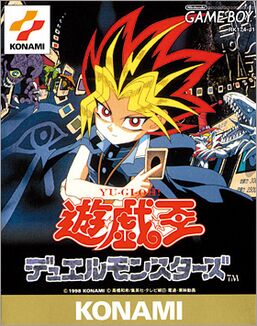 | |||||||||||
| Names | |||||||||||
|---|---|---|---|---|---|---|---|---|---|---|---|
| English | Yu-Gi-Oh! Duel Monsters | ||||||||||
| |||||||||||
| Development | |||||||||||
| Platform | Game Boy | ||||||||||
| Languages | Japanese | ||||||||||
| Developer | Konami | ||||||||||
| Publisher | Konami | ||||||||||
| Release dates | |||||||||||
| Japanese | December 16, 1998[1] | ||||||||||
| Series | |||||||||||
| Series | Duel Monsters | ||||||||||
| Next | Duel Monsters II: Dark duel Stories | ||||||||||
| Links | |||||||||||
| |||||||||||
Yu-Gi-Oh! Duel Monsters is the second Yu-Gi-Oh! video game, following Yu-Gi-Oh! Monster Capsule: Breed and Battle. It is the first game in the Duel Monsters series, followed by Yu-Gi-Oh! Duel Monsters II: Dark duel Stories, and the only game released for the Game Boy.
This game predates the OCG by two months, and many cards seen here soon made appearances in the earliest OCG sets. It was published in Japan by Konami on December 16, 1998;[1] while a few (non-Yu-Gi-Oh!-related) games would be released for the handheld over the next four years, Duel Monsters was one of the last games published for the original Game Boy.
Contents
Cards[edit]
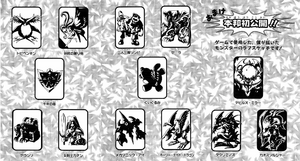
Duel Monsters features 365 cards. These consist of:
- 300 monsters and 50 Magic Cards accessible during normal gameplay:
- 100 monsters and 12 Magic Cards from the Yu-Gi-Oh! manga.
- The majority of these cards appear in chapters up to and including Duel 91: "Death to the Undead!", released July 27, 1998.
- Card #217: "B. Skull Dragon" appears later in Duel 96: "The Deadly Guardian!!", released September 7, 1998. Unlike the other manga monsters, its card number is not within the first 100.
- Card #067: "Perfectly Ultimate" is mentioned but not seen in the manga. It makes its first visual appearance in this game.
- Card #013: "Tyhone", which previously appeared in Yu-Gi-Oh! Monster Capsule: Breed and Battle
- 199 monsters and 38 Magic Cards, original to the game
- At least 9 of these monsters were designed by fans.
- 100 monsters and 12 Magic Cards from the Yu-Gi-Oh! manga.
- 15 secret monsters, at least 13 of which were designed by Kazuki Takahashi. These can only be obtained through a secret password menu or as prizes at the national tournament.
- One of the 15, #364: "Black Luster Soldi" appeared in the manga in Duel 117: "Running on the Edge!", released February 15, 1999, roughly coinciding with the date it was made publicly available in the game, February 21, 1999.
Game options[edit]
The following options are available at the main menu:
- Campaign (キャンペーン Kyanpēn): the game's story mode. Face AI opponents.
- Versus (たいせん Taisen): battle other players, using the Game Link Cable.
- Trade (トレード Torēdo): trade with other players via the Game Link Cable.
- Records (せいせき Seiseki): statistics and other information about the player.
There is also a password menu, which is only accessible by entering a secret code at the main menu.
Campaign[edit]
Duel Monsters is set during the Duelist Kingdom arc of the manga.
- The first stage is "In the Ship" (
船 の中 Fune no Naka).[2] It takes place on the Duelist Kingdom ship. - The second stage is "Duel Kingdom" (デュエル
王国 Dyueru Kingudamu).[2] It is set on the Duelist Kingdom island. - The third stage is "Simon Muran" (シモン・ムーラン Shimon Mūran), a stage unrelated to the manga arc, featuring a character who debuts in this game.
- The final boss stage is "Maximillion Pegasus", known as "Pegasus J. Crawford" (ペガサス・
J ・クロフォード Pegasasu Jē Kurofōdo) in Japan. - The dark stage is "Yami Yugi", known as "Dark Yugi" (
闇 遊 戯 Yami Yūgi) in Japan.
The player must defeat each character in a stage five times to advance to the next stage. A character that has been defeated five times can be Dueled additional times for more cards. Defeating Maximillion Pegasus five times causes the ending credits to roll. After that an additional Dark Stage appears, with Yami Yugi as an opponent.
A total of sixteen opponents are featured in Duel Monsters: four in Stage 1, nine in Stage 2, and one each in the last three stages.
| Stage | Opponents |
|---|---|
|
|
|
|
|
|
|
|
|
|
|
|
|
|
|
Versus[edit]
Players can battle other players, who have the same game, using the Game Link Cable via the Versus menu. The Deck can be altered before the battle, from this screen.
After a battle, the winner can take one card from the opponent's trunk. After every ten battles, the player is awarded a certain card.
If this option is selected without a second game being connected, Tea Gardner appears and prevents the action.
Trade[edit]
Players can trade cards with other people who have a copy of the game, via the Game Link Cable.
From the trade screen, the player has three options, "chest", "check card" and "exchange card". The player must open the "chest" menu and select which cards they wish to trade. They can review the cards they have selected in the "check card" screen. The cards are traded when both players select "exchange card".
Communication Fusions can be conducted by trading certain cards.
If this option is selected without a second game being connected, Tea Gardner prevents the action.
Records[edit]
The records screen shows the player's name and communication battle statistics.
Obtaining cards[edit]
Initial Deck[edit]
The player starts the game with a 40-card Initial Deck which includes 33 Monster Cards, selected randomly from a pool of 100 monsters, as well as seven Magic Cards, which are always the same.[3]
All cards in the Initial Deck are also available as drops, except for #337: "Raigeki", which can only be obtained as a victory bonus. In addition to being drops, sixteen other cards are also available as victory bonuses, and #289: "Change Slime" is available as a communication bonus (but not as a victory bonus). Victory bonus cards are indicated in the following tables with a pink background and a dagger (†) after the card's name, except for #337: "Raigeki", which instead uses a red background and a double dagger (‡).
For display purposes, the list of monsters is split into groups of ten. This has no significance in-game, and is only done here for viewing convenience.
| # | Card |
|---|---|
| 005 | Ryu-kishin† |
| 008 | Mushroom Man |
| 009 | Shadow Specter |
| 024 | Skull Servant |
| 029 | Mountain Warrior |
| 045 | Oscillo Hero #2† |
| 048 | Sangan |
| 058 | Kuriboh |
| 075 | Man-eating Plant† |
| 101 | Wings of Wicked Fl |
| # | Card |
|---|---|
| 102 | Mask of Darkness† |
| 105 | Tomozaurus |
| 107 | Kageningen |
| 123 | Dark Plant |
| 129 | Nemuriko |
| 130 | Weather Control |
| 134 | Mystical Capture C |
| 139 | B.eye Silv. Zombie |
| 140 | Toad Master |
| 142 | Flame Manipulator |
| # | Card |
|---|---|
| 143 | Chronolord |
| 144 | Wind Djinn |
| 145 | Phantom Thief† |
| 147 | Monster Egg |
| 148 | Sinister Shadow |
| 152 | The Melting Red Sh |
| 154 | Fire Reaper |
| 155 | Larvas† |
| 157 | Firegrass |
| 158 | Man Eater |
| # | Card |
|---|---|
| 159 | Dig Beak |
| 160 | M-warrior #1 |
| 161 | M-warrior #2† |
| 167 | Ancient Jar |
| 173 | Dark Prisoner |
| 174 | Hurricail† |
| 176 | Fire Eye |
| 177 | Monsturtle |
| 179 | Phantom Dewan |
| 180 | Arlownay† |
| # | Card |
|---|---|
| 181 | Dark Shade |
| 182 | Masked Clown |
| 183 | Lucky Trinket |
| 184 | Genin |
| 185 | Eyearmor |
| 187 | Gate Deeg |
| 188 | Synchar |
| 189 | Fusionist |
| 190 | Akakieisu |
| 191 | LaLa Li-oon |
| # | Card |
|---|---|
| 192 | Key Mace |
| 193 | Turtle Tiger |
| 194 | Terra the Terrible |
| 195 | Doron |
| 196 | Arma Knight |
| 197 | Mech Mole Zombie |
| 198 | Happy Lover |
| 199 | Penguin Knight† |
| 200 | Petit Dragon |
| 202 | Air Marmot of Nefa |
| # | Card |
|---|---|
| 203 | Phantom Ghost |
| 205 | Dorover |
| 206 | Twin Long Rods#1 |
| 207 | Droll Bird |
| 208 | Petit Angel |
| 209 | Winged Cleaver |
| 210 | Hinotama Soul |
| 211 | Kaminarikozou |
| 212 | Meotoko |
| 214 | B. Flame Kagemusha |
| # | Card |
|---|---|
| 215 | Flame Ghost |
| 218 | Two-mouth Darkrule |
| 222 | Midnight Fiend |
| 226 | Skull Stalker |
| 227 | Hitodenchak |
| 228 | Wood Remains |
| 229 | Hourglass of Life |
| 232 | Madjinn Gunn |
| 237 | Haniwa |
| 238 | Yashinoki† |
| # | Card |
|---|---|
| 239 | Vishwar Randi |
| 240 | The Drdek |
| 242 | Candle of Destiny |
| 243 | Water Element |
| 244 | Dissolverock |
| 245 | Meda Bat |
| 247 | Root Water |
| 253 | Angelwitch |
| 254 | Embryonic Beast |
| 261 | Wicked Mirror |
| # | Card |
|---|---|
| 268 | Sectarian of Secre |
| 271 | Megirus Light |
| 276 | Ray & Temperature† |
| 279 | King Fog |
| 282 | Mystical Sheep #2 |
| 285 | Serpent Marauder |
| 289 | Change Slime |
| 292 | Psychic Kappa |
| 298 | Wicked Dragon with |
| 300 | Kurama† |
| # | Card |
|---|---|
| 337 | Raigeki‡ |
| 338 | Mooyan Curry† |
| 339 | Red Medicine† |
| 343 | Sparks ×2 |
| 344 | Hinotama |
| 350 | Dark-piercing Ligh† |
Opponent drops[edit]
When an opponent is defeated, the player is given a card.
Each opponent has a different list of cards the player can get for beating them, with each card on the list having an assigned probability of randomly obtaining it. See Yugi Muto (Duel Monsters 1) § Drops for example.
Victory bonuses[edit]
The player wins a certain card from each opponent after every ten wins against that opponent, up to 100 wins.
Eighteen cards in the game are only available as victory bonuses; these are indicated in the below tables with a pink background and a superscript dagger (†) after the card's name. Specifically, the 100 victory bonus of every character is only available as a victory bonus, except for Mako Tsunami's 100 victory bonus, #337: "Raigeki", which the player's Initial Deck contains one copy of.
Fourteen victory bonuses are also available as communication bonuses, indicated with a yellow background and a superscript double dagger (‡). Sixteen victory bonuses are also available in the Initial Deck (though none of them are also communication bonuses), indicated with a green background and a superscript section sign (§). All of these, except for #337: "Raigeki", are also available as drops, as are all of the other victory bonuses which are otherwise available.
| Wins | # | Card |
|---|---|---|
| 10 | 314 | Horn of the Unicor |
| 20 | 350 | Dark-piercing Ligh§ |
| 30 | 199 | Penguin Knight§ |
| 40 | 161 | M-warrior #2§ |
| 50 | 114 | White Magical Hat |
| 60 | 270 | Wetha |
| 70 | 118 | Supporter in the S |
| 80 | 276 | Ray & Temperature§ |
| 90 | 039 | Curse of Dragon† |
| 100 | 038 | Gaia The Fierce Kn† |
| Wins | # | Card |
|---|---|---|
| 10 | 310 | Vile Germs |
| 20 | 312 | Silver Bow & Arrow |
| 30 | 238 | Yashinoki§ |
| 40 | 300 | Kurama§ |
| 50 | 155 | Larvas§ |
| 60 | 180 | Arlownay§ |
| 70 | 257 | Stone Armadiller |
| 80 | 174 | Hurricail§ |
| 90 | 252 | Nekogal #1 |
| 100 | 018 | L Leg of Forbidden† |
| Wins | # | Card |
|---|---|---|
| 10 | 333 | Sogen |
| 20 | 301 | Legendary Sword |
| 30 | 064 | Tiger Axe |
| 40 | 043 | Karbonala Warrior |
| 50 | 078 | Axe Raider |
| 60 | 014 | Battle Steer |
| 70 | 012 | Swamp Battleguard |
| 80 | 068 | Garoozis |
| 90 | 016 | Time Wizard‡ |
| 100 | 082 | Red-eyes B. Dragon† |
| Wins | # | Card |
|---|---|---|
| 10 | 335 | Yami |
| 20 | 236 | Guardian of the La |
| 30 | 338 | Mooyan Curry§ |
| 40 | 294 | Dragoness the Wick |
| 50 | 339 | Red Medicine§ |
| 60 | 259 | Dimensional Knight |
| 70 | 340 | Goblin's Secret Re‡ |
| 80 | 225 | Fiend Sword |
| 90 | 341 | Soul of the Pure† |
| 100 | 342 | Dian Keto the Cure† |
| Wins | # | Card |
|---|---|---|
| 10 | 330 | Forest |
| 20 | 050 | Basic Insect |
| 30 | 305 | Lazer Cannon Armor |
| 40 | 053 | Killer Needle |
| 50 | 306 | Insect Armor with |
| 60 | 054 | Gokibore |
| 70 | 049 | Big Insect |
| 80 | 055 | Giant Flea |
| 90 | 052 | Hercules Beetle‡ |
| 100 | 278 | Petit Moth† |
| Wins | # | Card |
|---|---|---|
| 10 | 332 | Mountain |
| 20 | 327 | Follow Wind |
| 30 | 062 | Harpie Lady |
| 40 | 318 | Elegant Egotist |
| 50 | 272 | Mavelus |
| 60 | 316 | Electro-whip‡ |
| 70 | 117 | Spirit of the Book |
| 80 | 125 | Faith Bird |
| 90 | 317 | Cyber Shield‡ |
| 100 | 063 | Harpie Lady Sister† |
| Wins | # | Card |
|---|---|---|
| 10 | 331 | Wasteland |
| 20 | 326 | Raise Body Heat |
| 30 | 080 | Uraby |
| 40 | 081 | Crawling Dragon #2 |
| 50 | 011 | Sword Arm of Drago‡ |
| 60 | 080 | Uraby |
| 70 | 081 | Crawling Dragon #2 |
| 80 | 011 | Sword Arm of Drago‡ |
| 90 | 079 | Megazowler‡ |
| 100 | 032 | Two-headed King Re† |
| Wins | # | Card |
|---|---|---|
| 10 | 334 | Umi |
| 20 | 328 | Power of Kaishin |
| 30 | 309 | Steel Shell |
| 40 | 070 | Fiend Kraken |
| 50 | 071 | Jellyfish |
| 60 | 073 | Kairyu-shin‡ |
| 70 | 070 | Fiend Kraken |
| 80 | 071 | Jellyfish |
| 90 | 073 | Kairyu-shin‡ |
| 100 | 337 | Raigeki§ |
| Wins | # | Card |
|---|---|---|
| 10 | 302 | Sword of Ruin |
| 20 | 321 | Malevolent Nuzzler |
| 30 | 005 | Ryu-kishin§ |
| 40 | 077 | Grappler |
| 50 | 091 | Mystic Horseman |
| 60 | 023 | The Wicked Worm B |
| 70 | 026 | Battle Ox‡ |
| 80 | 033 | Judge Man |
| 90 | 090 | Gyakutenno Megami‡ |
| 100 | 001 | B.eye White Dragon† |
| Wins | # | Card |
|---|---|---|
| 10 | 336 | Dark Hole |
| 20 | 313 | Horn of Light |
| 30 | 324 | Invigoration |
| 40 | 075 | Man-eating Plant§ |
| 50 | 102 | Mask of Darkness§ |
| 60 | 076 | Krokodilus |
| 70 | 051 | Armored Lizard‡ |
| 80 | 066 | Kojikocy‡ |
| 90 | 234 | Beautiful Headhunt |
| 100 | 017 | R Leg of Forbidden† |
| Wins | # | Card |
|---|---|---|
| 10 | 320 | Stop Defense |
| 20 | 119 | Trial of Nightmare |
| 30 | 233 | Dark Titan of Terr |
| 40 | 163 | Lisark |
| 50 | 165 | The Judgement Hand |
| 60 | 297 | Cyber Soldier of D |
| 70 | 136 | Witty Phantom |
| 80 | 275 | Terra Bugroth |
| 90 | 286 | Gatekeeper |
| 100 | 019 | R Arm of Forbidden† |
| Wins | # | Card |
|---|---|---|
| 10 | 335 | Yami |
| 20 | 303 | Dark Energy |
| 30 | 083 | Castle of D. Magic |
| 40 | 088 | Metal Guardian |
| 50 | 086 | Barox |
| 60 | 084 | Reaper of the Card |
| 70 | 281 | Mystic Clown |
| 80 | 087 | Dark Chimera |
| 90 | 127 | Ansatsu |
| 100 | 085 | King of Yamimakai† |
| Wins | # | Card |
|---|---|---|
| 10 | 325 | Machine Conversion |
| 20 | 322 | Violet Crystal |
| 30 | 098 | Clown Zombie |
| 40 | 036 | The Snake Hair |
| 50 | 093 | Zanki |
| 60 | 286 | Gatekeeper |
| 70 | 094 | Crawling Dragon |
| 80 | 124 | Ancient Tool |
| 90 | 099 | Pumpking the King† |
| 100 | 020 | L Arm of Forbidden† |
| Wins | # | Card |
|---|---|---|
| 10 | 323 | Book of Secret Art |
| 20 | 311 | Black Pendant |
| 30 | 304 | Axe of Despair |
| 40 | 307 | Elf's Light |
| 50 | 308 | Beast Fangs |
| 60 | 213 | Aqua Madoor |
| 70 | 145 | Phantom Thief§ |
| 80 | 106 | Spirit of the Wind |
| 90 | 022 | Summoned Skull‡ |
| 100 | 042 | Faceless Mage† |
| Wins | # | Card |
|---|---|---|
| 10 | 284 | Tao the Chanter |
| 20 | 241 | Dark Assailant |
| 30 | 040 | Dragon Piper |
| 40 | 287 | Ogre of the Black |
| 50 | 045 | Oscillo Hero #2§ |
| 60 | 329 | Dragon Capture Jar‡ |
| 70 | 291 | Fireyarou |
| 80 | 149 | Lord of the Lamp |
| 90 | 044 | Rogue Doll |
| 100 | 315 | Dragon Treasure† |
| Wins | # | Card |
|---|---|---|
| 10 | 006 | Feral Imp |
| 20 | 007 | Winged Dragon #1 |
| 30 | 041 | Celtic Guardian |
| 40 | 319 | Mystical Moon |
| 50 | 010 | Blackland Fire Dra |
| 60 | 348 | Swords of Revealin |
| 70 | 031 | Koumori Dragon |
| 80 | 060 | Great White |
| 90 | 345 | Final Flame |
| 100 | 021 | Exod. of Forbidden† |
Communication bonuses[edit]
The player receives a certain card after every ten battles against different human opponents via the Game Link Cable, up to 200 unique opponents. While fifteen of these cards are also available as drops and victory bonuses, five of them can only be obtained as communication bonuses; these are indicated in the below table with a pink background and a superscript dagger (†) after the card's name.
The card #347: "Tremendous Fire" was notoriously powerful in this game, with the ability to instantly inflict 5000 damage. It is also considered one of the most difficult cards to unlock, requiring to battle 200 different opponents.
Because no official method of erasing a saved game was ever published, players could not easily keep resetting a second copy of the game to face more unique opponents. However, there is a secret method to erase the saved game coded into the game. To achieve this, players can press the following buttons at the title screen: ↓, ↑, B, ↓, ↓, →, ↑, ↑, ↑, ↑, B + ↓. Other non-standard methods of erasing the save file involve directly tampering with the cartridge, which risks damaging it or the console used to play it.
| Opponents | # | Card |
|---|---|---|
| 10 | 289 | Change Slime |
| 20 | 015 | Flame Swordsman† |
| 30 | 026 | Battle Ox |
| 40 | 329 | Dragon Capture Jar |
| 50 | 004 | Baby Dragon† |
| 60 | 051 | Armored Lizard |
| 70 | 340 | Goblin's Secret Re |
| 80 | 316 | Electro-whip |
| 90 | 011 | Sword Arm of Drago |
| 100 | 349 | Spellbinding Circl† |
| 110 | 016 | Time Wizard |
| 120 | 090 | Gyakutenno Megami |
| 130 | 066 | Kojikocy |
| 140 | 052 | Hercules Beetle |
| 150 | 346 | Ookazi† |
| 160 | 317 | Cyber Shield |
| 170 | 079 | Megazowler |
| 180 | 073 | Kairyu-shin |
| 190 | 022 | Summoned Skull |
| 200 | 347 | Tremendous Fire† |
Trading[edit]
Cards can be traded from other games using the Game Link Cable.
Duel Monsters can connect with other copies of Duel Monsters. Duel Monsters II: Dark duel Stories, Duel Monsters III: Tri-Holy God Advent (the Japanese edition of Dark Duel Stories), and Duel Monsters 4: Battle of Great Duelist can connect to copies of Duel Monsters.
Communication Fusion[edit]
Communication Fusions can be performed by connecting to a second copy of Duel Monsters or to a copy of Duel Monsters II: Dark duel Stories, using the Game Link Cable. This requires the two Fusion Materials and #289: "Change Slime". "Change Slime" has a chance of being included in the Initial Deck; after that, it can only be obtained with a chance of 1/2048 per Duel against certain opponents, or as the first communication bonus after battling against ten different opponents over the Game Link Cable.
Eight different cards are available as Communication Fusions, and none of them can be obtained by any other method in-game, though all of them can be traded back from later games.
#067 "Perfectly Ultimate" requires a total of eight Communication Fusions to obtain, each of which requires a copy of "Change Slime"; it also requires three copies of #278: "Petit Moth", which is only available as Weevil Underwood's 100 victory bonus. Because of this, it is considered to be an extremely difficult card to obtain.
| Fusion Monster | Material 1 | Material 2 | |||
|---|---|---|---|---|---|
| 037 | Gaia the Dragon Ch | 038 | Gaia The Fierce Kn | 039 | Curse of Dragon |
| 069 | Thousand Dragon | 004 | Baby Dragon | 016 | Time Wizard |
| 092 | Rabid Horseman | 026 | Battle Ox | 091 | Mystic Horseman |
| 056 | Larvae Moth | 278 | Petit Moth | 123 | Dark Plant |
| 157 | Firegrass | ||||
| 274 | Green Phantom King | ||||
| 273 | Ancient Tree of En | ||||
| 008 | Mushroom Man | ||||
| 075 | Man-eating Plant | ||||
| 158 | Man Eater | ||||
| 238 | Yashinoki | ||||
| 180 | Arlownay | ||||
| 072 | Cocoon of Evolutio | 056 | Larvae Moth | 123 | Dark Plant |
| 157 | Firegrass | ||||
| 274 | Green Phantom King | ||||
| 273 | Ancient Tree of En | ||||
| 008 | Mushroom Man | ||||
| 075 | Man-eating Plant | ||||
| 158 | Man Eater | ||||
| 238 | Yashinoki | ||||
| 180 | Arlownay | ||||
| 057 | Great Moth | 072 | Cocoon of Evolutio | 072 | Cocoon of Evolutio |
| 067 | Perfectly Ultimate | 057 | Great Moth | 072 | Cocoon of Evolutio |
| 217 | B. Skull Dragon | 022 | Summoned Skull | 082 | Red-eyes B. Dragon |
Ante[edit]
After a communication battle, the winner must take one card from their opponent's trunk.
Passwords[edit]
Nine of the fifteen secret cards in Duel Monsters can be unlocked via passwords. These passwords use kana, rather than numbers or letters. Each password is the name of a staff member who worked on the game, or who worked on the manga series at Shueisha at the time. Many later video games instead use passwords which consist of eight digits, found on cards released in the Yu-Gi-Oh! Official Card Game, which did not premiere until after this game was released.
To access the password entry, the following button sequence must be entered on the main menu: ↑, ↓, B, ↓, ↓, ↑+B, B. This requires frame-perfect input to succeed; if the game is being played on an emulator, the password entry can also be accessed by changing RAM address $DFDE to 0x06 and pressing B. Alternatively, the Game Genie code 06F-DE2-F7E can be used, which removes the requirement for frame-perfect button entry and reduces the button sequence to ↑, ↓, B, ↓, ↓, B.
After successfully entering the button sequence, Yami Yugi appears and introduces the password mode, and then the player can enter a password. The screens used for password entry are the hiragana and katakana entry screens used to enter the player's name at the start of the game. Once a password is entered, Yami Yugi appears again and tells the player whether the entered password is correct, incorrect, or has already been used, and the game returns to the main menu.
The Passwords and instructions on how to access the Password menu were published in various supplementary material, including:
- Top Secret Cards
- Yu-Gi-Oh! Duel Monsters Perfect Master BOOK, released December 21, 1998
- The 1999 #2 issue of V Jump, released December 21, 1998
- The 1999 #9 issue of Weekly Shōnen Jump, released January 25, 1999
- The 1999 #4 issue of V Jump, released February 21, 1999
- Yu-Gi-Oh Duel Monsters II: Dark duel Stories Ultimate Strategy Book Volume 2, released August 5, 1999
| # | Card | Password | Rōmaji | Individual | Sources |
|---|---|---|---|---|---|
| 351 | Yaranzo | ヘイシヨシヒサ | heishiyoshihisa | Yoshihisa Heishi, long-time editor for Weekly Shōnen Jump | Top Secret Card |
| VJ 1999 #4 | |||||
| DM2 Strategy V2 | |||||
| 352 | Kanan the Swordmis | ハシモトカナコ | hashimotokanako | Kanako Hashimoto, director of graphics for Duel Monsters | Top Secret Card |
| 353 | Takriminos | チダタクリ | chidatakuri | Takuri Chida, programmer for Duel Monsters | Top Secret Card |
| VJ 1999 #4 | |||||
| DM2 Strategy V2 | |||||
| 354 | Stuffed Animal | キタウエカズミ | kitauekazumi | Kazumi Kitaue, executive producer for Duel Monsters | Perfect Master BOOK |
| VJ 1999 #2 | |||||
| DM2 Strategy V2 | |||||
| 355 | Megasonic Eye | シモムラサトシ | shimomurasatoshi | Satoshi Shimomura, producer for Duel Monsters | |
| 358 | Seiyaryu | トリシマカズヒコ | torishimakazuhiko | Kazuhiko Torishima, editor-in-chief for Weekly Shōnen Jump | VJ 1999 #4 |
| DM2 Strategy V2 | |||||
| 359 | Three-legged Zombi | タカハシトシマサ | takahashitoshimasa | Toshimasa Takahashi, editor for Weekly Shōnen Jump | Top Secret Card |
| VJ 1999 #2 | |||||
| DM2 Strategy V2 | |||||
| 361 | Flying Penguin | ヤマダノブヒロ | yamadanobuhiro | Nobuhiro Yamada, director of game design for Duel Monsters | WSJ 1999 #9 |
| VJ 1999 #2 | |||||
| DM2 Strategy V2 | |||||
| 363 | Fairy's Gift | タカハシカズキ | takahashikazuki | Kazuki Takahashi, creator of Yu-Gi-Oh! and original monster design in Duel Monsters | WSJ 1999 #9 |
| VJ 1999 #2 | |||||
| DM2 Strategy V2 |
Top Secret Card with "Three-legged Zombi" password
Perfect Master BOOK with "Stuffed Animal" password
Weekly Shōnen Jump 1999 #9 with "Fairy's Gift" and "Flying Penguin" passwords
V Jump 1999 #2 with "Takriminos", "Yaranzo", and "Three-legged Zombi" passwords
V Jump 1999 #4 with "Fairy's Gift", "Seiyaryu", "Flying Penguin" and "Stuffed Animal" passwords
Duel Monsters II: Dark duel Stories Ultimate Strategy Book Volume 2 with seven of the nine passwords
Prizes[edit]
Eight of the fifteen secret cards were awarded at the Duel Monsters National Tournament on February 21, 1999. Physical copies of the top four cards were also awarded.
While two of the qualifying cards can also be unlocked with a password, and the four qualifying cards can be obtained by trading from Duel Monsters II: Dark duel Stories, the Top 4 cards cannot be obtained legitimately by any other means.
| Position | # | Card | Physical card |
|---|---|---|---|
| Qualifying | 352 | Kanan the Swordmis | |
| 362 | Millennium Shield | ||
| 355 | Megasonic Eye | ||
| 357 | Yamadron | ||
| Top 4 | 365 | Fiend's Mirror | Fiend's Mirror |
| Top 3 | 356 | Super War-lion | Super War-lion |
| Top 2 | 360 | Zera The Mant | Zera The Mant |
| Winner | 364 | Black Luster Soldi | Black Luster Soldi |
Temporarily obtaining cards[edit]
Fusion Summon[edit]
The Extra Deck does not exist in this game. Instead, Fusion Summons are performed during Duels by trying to Summon a monster from the hand on top of a monster on the field. The game features 2,159 fusions, resulting in 52 different monsters; often the same monster can be Summoned using a variety of Fusion Material, though eight of the monsters have only a single possible fusion.
All but one of the fusions in Duel Monsters use only monsters as material. The exception is #063: "Harpie Lady Sister", which is fused by equipping #062: "Harpie Lady" with #318: "Elegant Egotist". In the ROM, this fusion is handled as an effect, and is not stored with the monster-only fusions.
While the player does not receive a permanent copy of a monster Summoned by fusion, if a fused monster was not previously encountered, an entry for it is added.
Evolution[edit]
#278 "Petit Moth" and its stages evolve into other cards after being on the field for one turn, in the order shown below. Permanent copies of the evolutions are not added to the player's trunk, though if the player has not previously encountered one of the evolutions, an entry for it is added, similar to fused monsters.
#278 "Petit Moth" → #056: "Larvae Moth" → #072: "Cocoon of Evolutio" → #057: "Great Moth" → #067: "Perfectly Ultimate"
Only one copy of "Petit Moth" can be acquired per game, by defeating Weevil Underwood one hundred times (it can also be traded back from later games). Permanent copies of its evolutions can only be acquired by Communication Fusion.
Having only 300 ATK and 200 DEF, and with AI opponents attacking when they have a stronger monster, it is usually difficult to keep "Petit Moth" on the field for a turn; there are only thirteen monsters in the game with a base ATK of 300 or less. "Petit Moth" can be protected in a few different ways:
- Tristan Taylor does not have any monsters with more than 300 ATK and does not go out of his way to fuse cards, so will not attack an Attack Position "Petit Moth".
- "Petit Moth" is strengthened by all Field Magic Cards in the game. By default, this would only increase its stats to 390 ATK and 260 DEF, which would not be enough to protect it from any additional monsters (the base ATK values featured in the game jump directly from 200 to 300, and from 300 to 400). However, "Petit Moth" is a special case: instead of its stats being increased by 30%, they are increased to 750 ATK and 450 DEF, except for when #330: "Forest" is active, which instead increases its stats to 975 ATK and 585 DEF. These boosts are enough to protect it against dozens of additional monsters (over a hundred in the case of "Forest").
- #349: "Spellbinding Circl" reduces the targeted monster's level by 1; using it on a monster with a level of 0 reduces its level to -1, which reduces its ATK and DEF to 60% of their original values. This would require a separate copy of "Spellbinding Circl" for each of the opponent's monsters, as well as an extra turn for each monster to be debuffed. This would protect "Petit Moth" against any monsters with up to 500 ATK, and could be used in conjunction with a Field Magic Card increasing the ATK of "Petit Moth", to protect against additional monsters.
- #348: "Swords of Revealin" prevents the opponent from attacking for three turns.
The game's code allows certain Equip Cards to be used on "Petit Moth". However, since only a single card can be played per turn, and because "Petit Moth" is evolved into "Larvae Moth" as soon as its controller's next turn starts, it is not actually possible to equip any cards to "Petit Moth" before it evolves.
Rules[edit]
Yu-Gi-Oh! Duel Monsters predates the Yu-Gi-Oh! Official Card Game and features its own rules for Duel Monsters, most of which are based on the manga Duel Monsters rules.
Deck construction[edit]
- A player's Deck must contain exactly 40 cards.
- This is a hard cap: even when editing the Deck, only up to 40 cards can be used. Because of this, to change cards requires that a card first be removed from the Deck, before the new card can be added.
- A Deck can have up to 40 copies of the same card.
Duels[edit]
Setup[edit]
- Each player starts with 8000 LP and five cards in their hand.
- In campaign, the human player always goes first.
Playing cards[edit]
- Except for the first turn, the player draws one card at the beginning of their turn.
- A player may play one card per turn.
- A player can Summon a monster into one of the five available zones or activate a Magic Card.
- If a player attempts to Summon a monster into a zone occupied by another monster, the game will attempt to fuse the monsters. If the Fusion is valid, a new monster will be Summoned into the zone. If the Fusion is invalid, the second monster will replace the first.
Modifying ATK/DEF[edit]
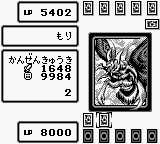
- Certain Magic Cards will modify the ATK and DEF of a chosen monster by boosting or reducing its level: Equip Magic Cards will boost the monster's level by 1 each, to a maximum of 2 levels, while #349: "Spellbinding Circl" will reduce its level by 1. Each level increases a monster's ATK and DEF by 60%; #303: "Dark Energy" is the only card that specifies this increase.
- "Spellbinding Circl" can reduce a monster's level to -1. In this case, its ATK and DEF are reduced to 60% of their original values; for example, #207: "Droll Bird", with original ATK and DEF of 600 and 500, has its ATK and DEF become 360 and 300.
- Every monster is a valid target for at least one Equip Card. Nineteen monsters are valid targets for only one Equip Card.
- Field Magic Cards affect all monsters on the field of specified Types. A Field Card may either increase a monster's ATK and DEF by 30%, decrease them by 30%, or have no effect. There can only be one Field Card active at a time; if a Field Card is active, any further Field Cards attempted to be played will be destroyed. This increase/decrease does not count towards the number of levels.
- There are several monsters which are affected, or unaffected, by certain Field Cards contrary to their Type, as well as several which receive additional boosts over the normal 30% or are otherwise modified:
- #278: "Petit Moth", whose stats are changed from 300 ATK and 200 DEF to 750 ATK and 450 DEF, before gaining its 30% or 0% boost: it has 975 ATK and 585 DEF in #330: "Forest" and 750 ATK and 450 DEF in any other field, excluding the default field.
- PaniK's monsters, whose stats are rounded to the nearest 100 after gaining their 30% boost.
- #074: "Giant Rock Soldier", which is affected by #332: "Mountain", contrary to its Type.
- #027: "Beaver Warrior" and #047: "Torike", which are not affected by "Forest", contrary to their Type.
- There are no Field Cards which affect "Torike" or any Reptile monsters.
- Fairy monsters (under #335: "Yami") and Machine and Pyro monsters (under #334: "Umi") only receive negative effects from Field Cards. These are the only monsters to receive negative effects.
- Several monsters have 0 ATK or DEF; these values are unchanged by a Field Card even if it does affect the non-zero value.
- Because of how they are implemented (as a set of hardcoded values), boosts from Field Cards are applied before level boosts, though this has no in-game effect.
- There are several monsters which are affected, or unaffected, by certain Field Cards contrary to their Type, as well as several which receive additional boosts over the normal 30% or are otherwise modified:
- Due to a glitch, ATK and DEF values of over 9999 do not work correctly; the 10,000's digit is ignored. For example, #067: "Perfectly Ultimate", which has an original ATK of 3500, would have a boosted ATK of 11648 when boosted by a Field Card and two levels, but this glitch makes its functional ATK only 1648. This glitch can only affect the ATK values of "Perfectly Ultimate" and #217: "B. Skull Dragon", as no other original ATK and DEF values in the game are over 3000; a value of 3000 becomes 9984 after being boosted by a Field Card and two levels.
Battling[edit]
- Each turn, the player must decide if each of their monsters is going to attack or defend.
- If "attack" is selected, the monster is put in Attack Position and must attack a monster on the opponent's side of the field. If there are none, it will attack the opponent directly. A monster cannot be left in Attack Position at the end of a turn, without declaring an attack, unless it is the first turn or another card is preventing it from attacking.
- When a monster attacks a player directly, the monster's ATK is deducted from the LP of the attacked player.
- When a monster attacks an Attack Position monster, the monster with lower ATK is destroyed and the difference is deducted from the LP of the controller of the destroyed monster. If both monsters have the same ATK, they are both destroyed.
- When a monster attacks a Defense Position monster, if the attacking monster's ATK is higher than the defending monster's DEF, the defending monster is destroyed. If the attacking monster's ATK is equal to or lower than the DEF of the defending monster, the difference is deducted from the LP of the controller of the attacking monster, and neither monster is destroyed.
- If "defend" is selected, the monster is put in Defense Position.
- If "attack" is selected, the monster is put in Attack Position and must attack a monster on the opponent's side of the field. If there are none, it will attack the opponent directly. A monster cannot be left in Attack Position at the end of a turn, without declaring an attack, unless it is the first turn or another card is preventing it from attacking.
- The turn ends after the player has chosen an action for all of their monsters.
Winning[edit]
- When a player's LP are reduced to 0, the other player is the winner.
- If a player's hand is empty, the Duelist with the higher LP wins
- If a player has all five "Exodia" pieces in their hand, they win.
Development[edit]
Announcements[edit]
In Weekly Shōnen Jump 1998 #26, released on May 25, production of Yu-Gi-Oh! Duel Monsters was announced. The announcement featured screenshots of the game including the main menu, a Duel in progress, and the Puppeteer of Doom in the campaign mode. All three screens were changed significantly by the time the game was released. The feature also showed the in-game artworks of "B.eye White Dragon" and "Hitotsu-me Giant", and contained an invitation for people to submit designs for monsters to be included in Duel Monsters and Yu-Gi-Oh! Monster Capsule: Breed and Battle, which was being developed alongside it. The deadline for submissions was June 25, 1998. Applicants were asked to put their monster's name and picture on a postcard, and optionally its powers and stats, along with their name, address, phone number and age, and send the postcard to the Yu-Gi-Oh! Koku address. Copyright of the winning entries was to be taken over by the organizers.
Weekly Shōnen Jump 1998 #28, released on June 8, contained the in-game artworks and some information on "Ryu-kishin" and "Feral Imp".
Weekly Shōnen Jump 1998 #36, released on August 3, mentioned that players could play against and trade with friends using the Game Link Cable or play against characters appearing in the manga. It contained a screenshot of Weevil Underwood in campaign mode. The issue showcased four of the winners of the monster-design contest from issue #26; "Claw Reacher", "Hard Armor", "Turtle Tiger", and "Beast of Forest Destruction". However, "Beast of Forest Destruction" was not included in the final version of the game.
Weekly Shōnen Jump 1998 #40, released on August 31, announced that the game would contain 350 cards. It contained artworks for a number of cards and showed a screenshot of Mai Valentine in campaign mode, using Super Gameboy colors.
Weekly Shōnen Jump 1998 #42, released on September 14, announced that trial versions of the game would be playable at six stores in Japan on the weekend of September 26 and 27, 1998 and gave the address and phone number of each venue. It explained that attendees who answered a questionnaire would be presented with a "Seiyaryu" promotional card, "Seiyaryu" being a card Kazuki Takahashi designed for the game.
V Jump 1998 #11, released on September 21, contained a screenshot of a Duel in progress and an explanation of everything that was visible on screen and the rules for monster battles. It showcased four winning entrants from the monster-design contest; "Dark Shade", "Twin Long Rods #1", "Genin", "Doron", and "Larvas".
Weekly Shōnen Jump 1998 #45, released on October 5, announced that the game would be released in December 1998. It contained a newer version of the main menu, different than the final version, but more closely resembling it than the one featured in the 1998 #26 issue. It also contained screenshots of the Deck edit screen, the Stage 1 opponents and the Stage 2 main screen. All screenshots used Super Gameboy colors.
Weekly Shōnen Jump 1998 #47, released on October 19, contained the precise release date of the game; December 17, 1998. It announced that a national tournament would take place, the winners of which would receive in-game cards and metallic real-world versions of the cards. It showed "Zera the Mant" and "Black Luster Soldier" in the style of the "collector's cards" that existed before the Yu-Gi-Oh! Official Card Game. The issue contained information on the Yu-Gi-Oh! Duel Monsters bundled promotional cards and the game's Initial Deck.
Weekly Shōnen Jump 1998 #48, released on October 26, contained information about the national tournament, including its schedule; qualifying rounds in mid-January 1999, second round of qualifiers in late January to early February, and finals in mid February. The first qualifying round took place at approximately 100 stores throughout Japan, with a rare card and qualification for the next second round awarded to winners. The second qualifying round was to take place at twelve locations, with a rare card and qualification for the finals awarded to winners. The final was to take place at Tokyo between 16 regional winners, with "Fiend's Mirror" awarded to the top four, "Super War-lion" to the top three, "Zera The Mant" to the top two and "Black Luster Soldi" and the ten Duel Monsters bundled promotional cards awarded to the winner.
Weekly Shōnen Jump 1998 #50, released November 9, published information on the first two stages of the game's campaign mode. It also included details of the trials that had been announced in the 1998 #42 issue. 2000 people attended; 600 got to play while the others were allowed to watch on a screen.
Weekly Shōnen Jump 1998 #52, released November 21, contained information on a visit Kazuki Takahashi made to the building where the game was developed.
Prototypes[edit]
An earlier version of the game featured a different graphic for the main menu. It did not include the copyright text, had a different font for the text Duel Monsters (デュエルモンスターズ), a different picture of Yami Yugi, and different text for the menu options:[4][5]
- VS CPU (対 CPU Tai Shī Pī Yū) instead of "Campaign" (キャンペーン Kyanpēn)
- VS MAN (対 MAN Tai Man) instead of "Versus" (たいせん Taisen)
- Trade (こうかん Kōkan) instead of "Trade" (トレード Torēdo)
- Collection (コレクション Korekushon) instead of "Records" (せいせき Seiseki)
An earlier version of the Puppeteer of Doom featured the Kaiba puppet more prominently with only a silhouette of the Puppeteer visible behind it.[4]
Card-design contest[edit]
Fans were able to submit ideas for cards to be included in the game. Four of the winners were published in the 1998 #36 issue of Weekly Shōnen Jump (WSJ). Another five were published in the 1998 #11 issue of V Jump (VJ). However one of the nine, "Beast of Forest Destruction" was not included in the final version of the game.
| # | Card | Designer | Original artwork | Game artwork | Winner announced |
|---|---|---|---|---|---|
| 155 | "Larvas" | Atsushi Nakao (中尾篤志) | 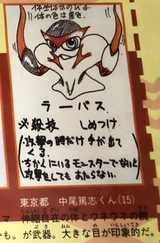
|
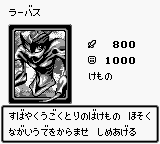
|
VJ 1998 #11 |
| 156 | "Hard Armor" | Kiichi Hayashi (林 貴一) | 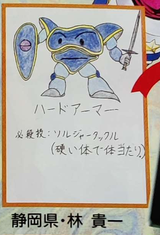
|
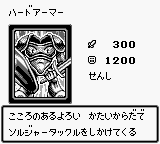
|
WSJ 1998 #36 |
| 178 | "Claw Reacher" | Hidekazu Ozaki (尾崎秀和) | 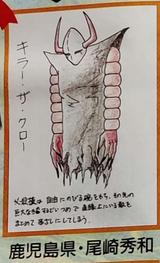
|
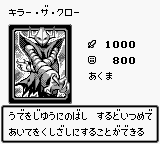
|
WSJ 1998 #36 |
| 181 | "Dark Shade" | Junko Kubo (久保淳子) | 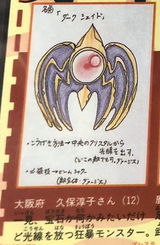
|
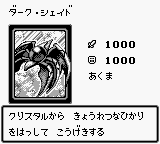
|
VJ 1998 #11 |
| 184 | "Genin" | Manabu Iwasaka (岩坂学) | 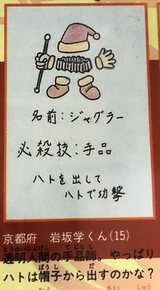
|
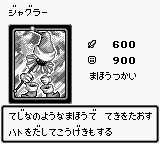
|
VJ 1998 #11 |
| 193 | "Turtle Tiger" | Masahiro Yamamoto (山本将弘) | 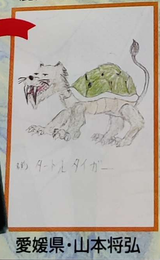
|
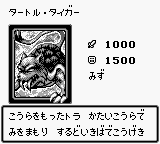
|
WSJ 1998 #36 |
| 195 | "Doron" | Takeshi Fujii (藤井武志) | 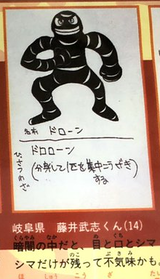
|
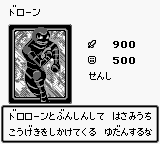
|
VJ 1998 #11 |
| 206 | "Twin Long Rods #1" | Yasushi Ibusuki (指宿泰志) | 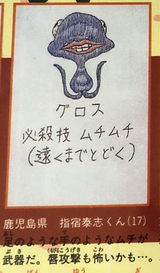
|
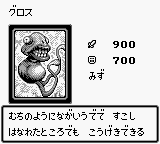
|
VJ 1998 #11 |
| n/a | "Beast of Forest Destruction" | Kentaro Miyamoto (宮本健太朗) | 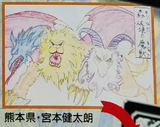
|
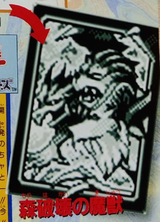
|
WSJ 1998 #36 |
Glitches[edit]
- ATK and DEF values over 9999 do not work correctly.
- When played on a PAL Super Game Boy, if the player attempts to access the versus or trade screens, Tea Gardner will not appear, though the player is still unable to complete the action.
Promotional cards[edit]
Each copy of Duel Monsters came with three collector's cards, randomly selected from the following ten:[1]
- "Black Skull Dragon"
- "Castle of Dark Illusions"
- "Dark Magician"
- "Hitotsu-Me Giant"
- "Mirror Force"
- "Monster Reborn"
- "Red-Eyes Black Dragon"
- "Ryu-Kishin"
- "Summoned Skull"
- "Swords of Revealing Light"
Another collector's card, "Seiyaryu", was given out at trial session for this game. Five copies of that card were also used as prizes in an Akamaru Jump raffle.
Game guides[edit]
Two game guides for Duel Monsters were published in Japan by Shueisha: Yu-Gi-Oh! Duel Monsters Perfect Master BOOK, published on December 21, 1998,[6][7] and Yu-Gi-Oh! Duel Monsters Perfect Master BOOK Volume 2, published in January 1999.[8] Neither guide included any bundled promotional cards.
Manga scenes used[edit]
The following scenes from the manga were used to create graphics for this game.
Gallery[edit]
Duel Monsters as it appears when played on a Super Game Boy
Reception[edit]
Duel Monsters sold 1.6 million copies,[9] making it the 34th-best-selling Game Boy/Game Boy Color title of all time.
External links[edit]
- The Cutting Room Floor page
- Data Crystal page
- Yu-Gi-Oh! Duel Monsters on The Spriters Resource
- Retro Achievements page
- English fan translation project
References[edit]
- ↑ a b c https://web.archive.org/web/20180826214725/http://www.konami.jp/products/yugioh_dm1_gb//
- ↑ a b Yu-Gi-Oh! Duel Monsters Perfect Master BOOK (in Japanese). Shueisha. December 21, 1998. p. 25. ISBN 4-08-779009-6.
- ↑ https://datacrystal.tcrf.net/wiki/Yu-Gi-Oh!_Duel_Monsters:ROM_map#Starter_Deck_-_Random_card_pool
- ↑ a b Weekly Shōnen Jump 1998 #26, released May 25, 1998
- ↑ V Jump 1998 #10, released August 1998
- ↑ Yu-Gi-Oh Duel Monsters Perfect Master BOOK (in Japanese). Shueisha. December 21, 1998. Back cover. ISBN 4-08-779009-6.
- ↑ "遊☆戯☆王デュエルモンスターズパーフェクトマスターBOOK (上巻) (Vジャンプブックス―ゲームシリーズ) [単行本]" [Yu-Gi-Oh! Duel Monsters Perfect Master BOOK (Volume 1) (V Jump Books - Game Series) [Paperback]] (in Japanese). Amazon.co.jp. Retrieved June 27, 2013.
- ↑ "遊☆戯☆王デュエルモンスターズパーフェクトマスターBOOK (下巻) (Vジャンプブックス―ゲームシリーズ) [単行本]" [Yu-Gi-Oh! Duel Monsters Perfect Master BOOK (Volume 2) (V Jump Books - Game Series) [Paperback]] (in Japanese). Amazon.co.jp. Retrieved June 27, 2013.
- ↑ "Japan Platinum Game Chart". The Magic Box. Retrieved April 25, 2017.
